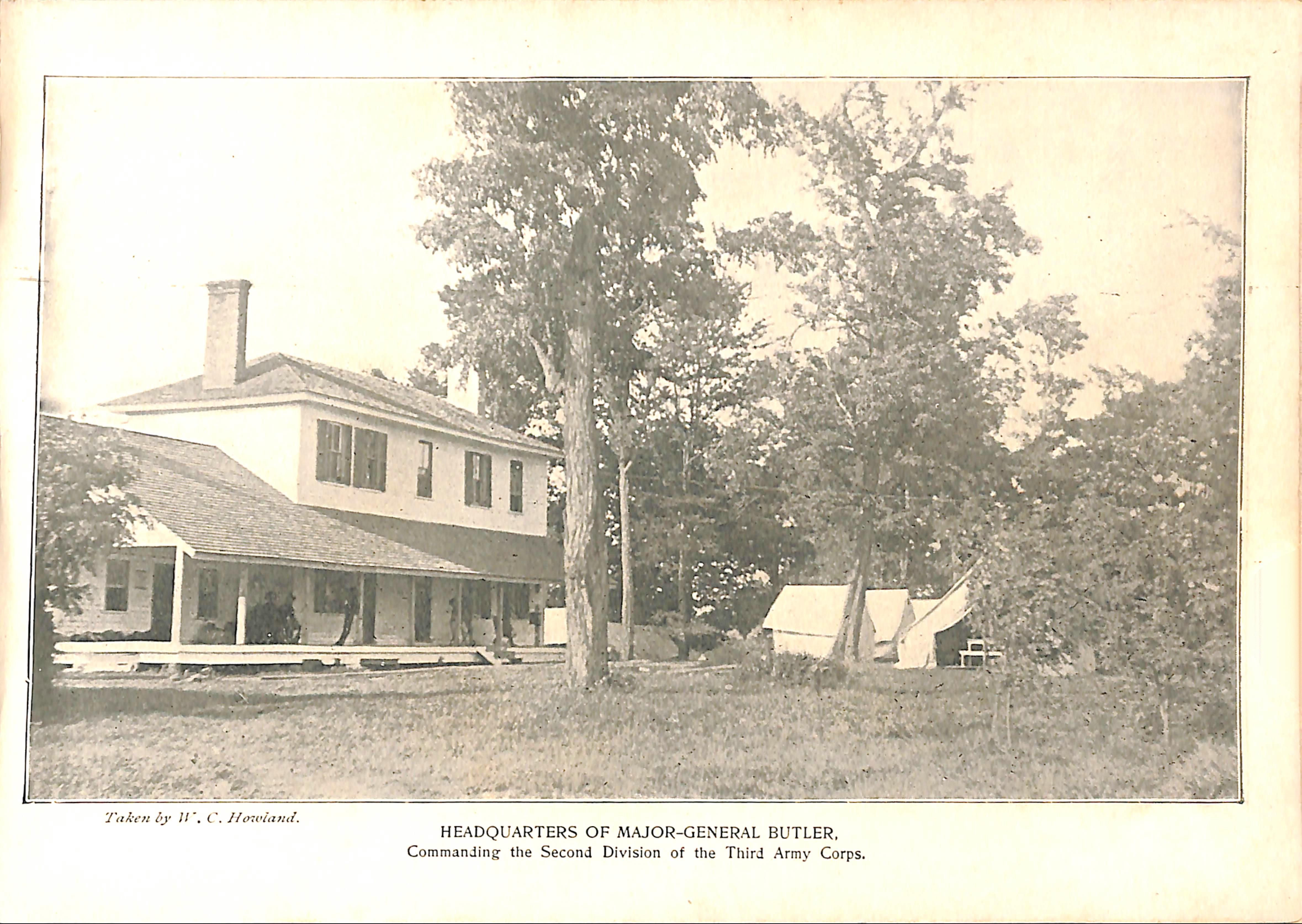
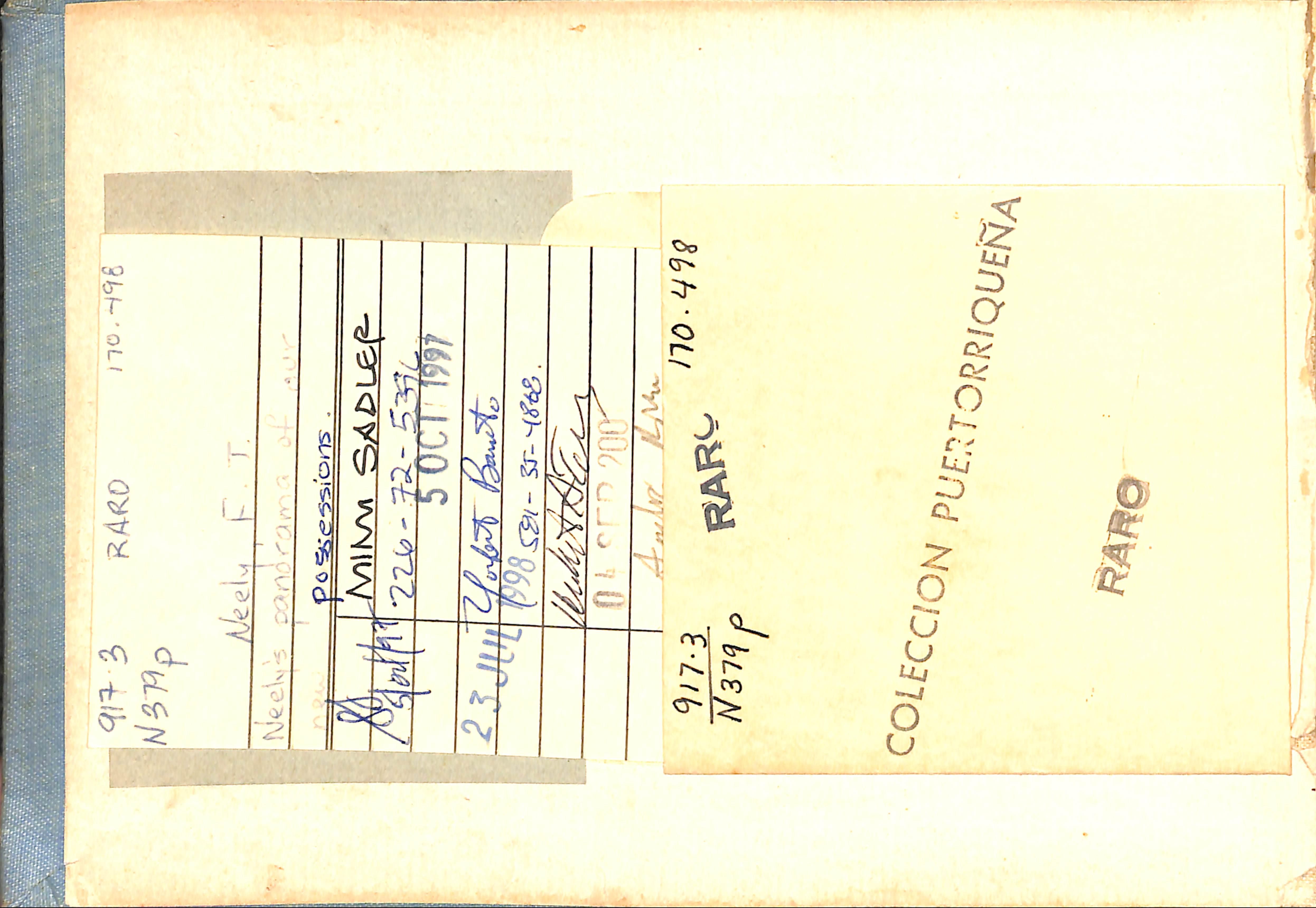









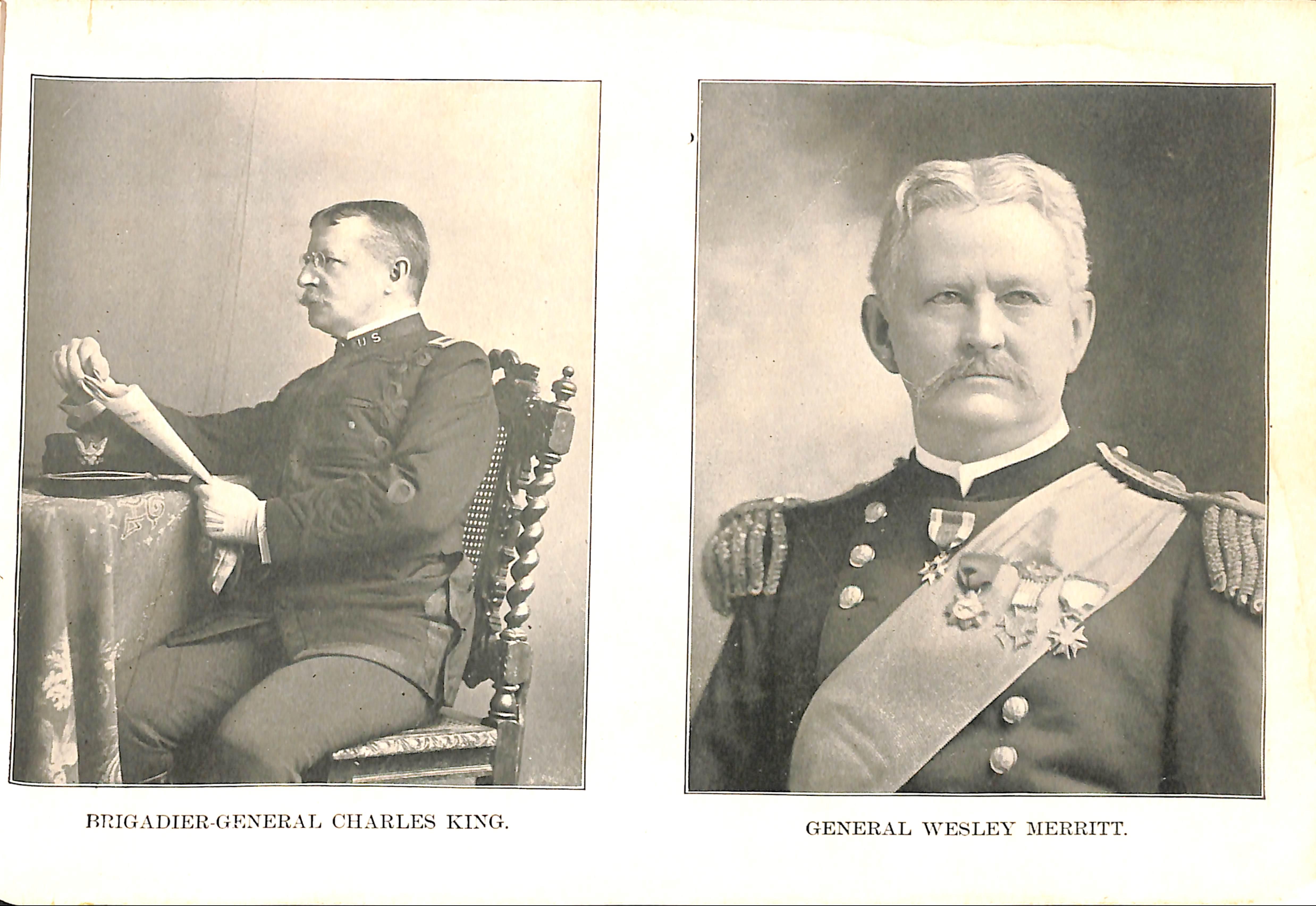
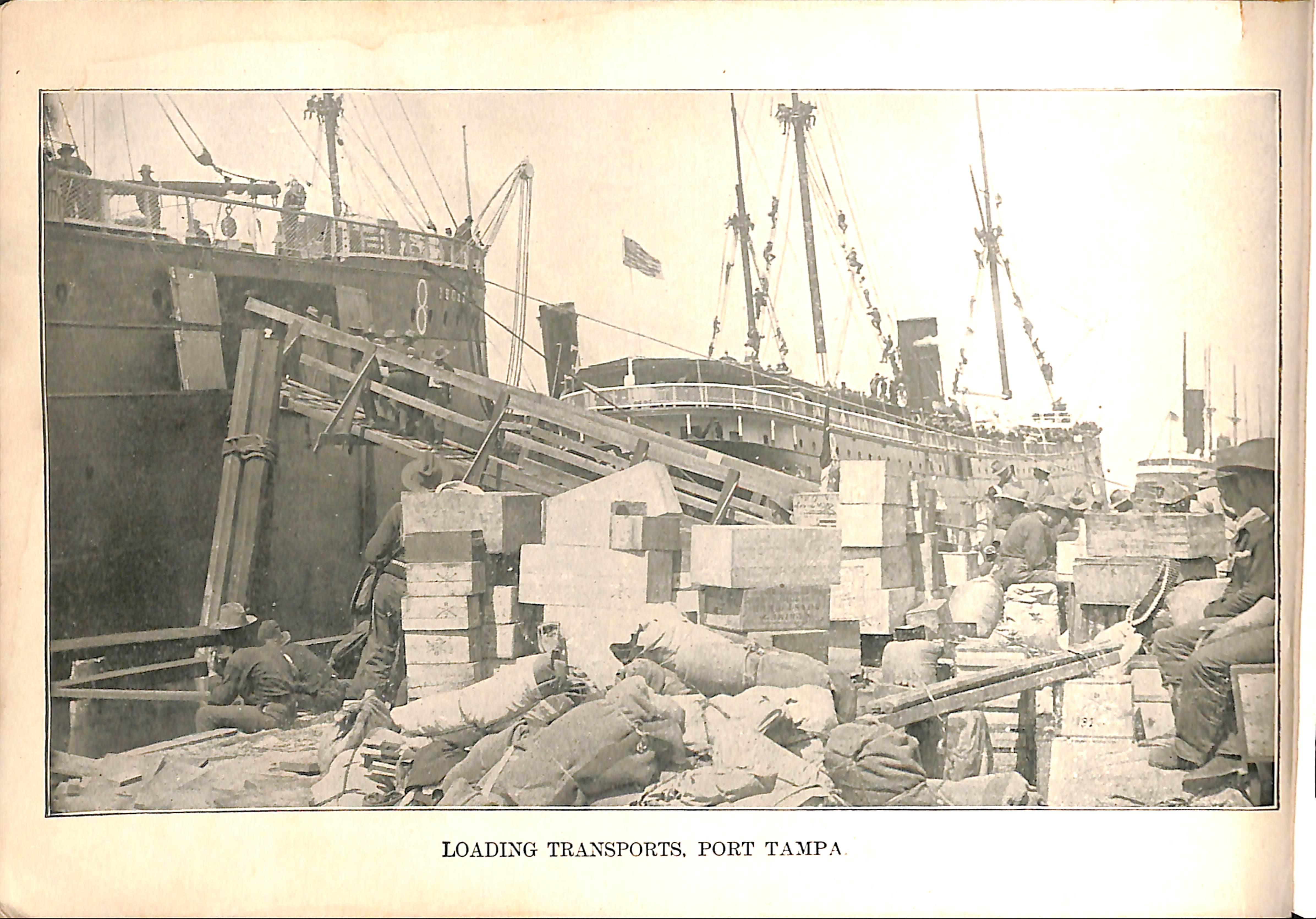
Copyright. Strohmeyer U^yífian.
fThe detention camp, froin Major-General Wheeler's headquarters, Camp WikoflE.
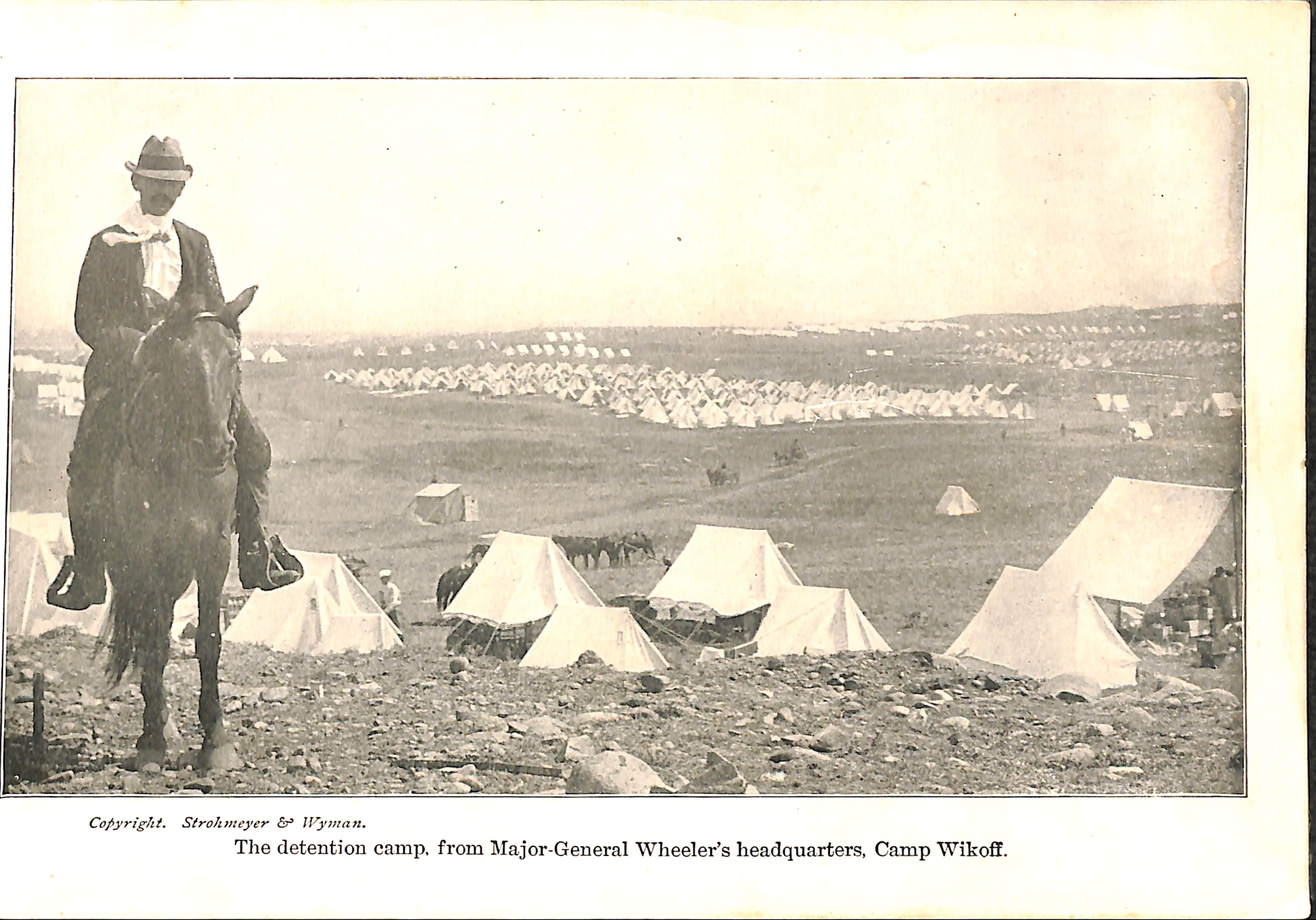



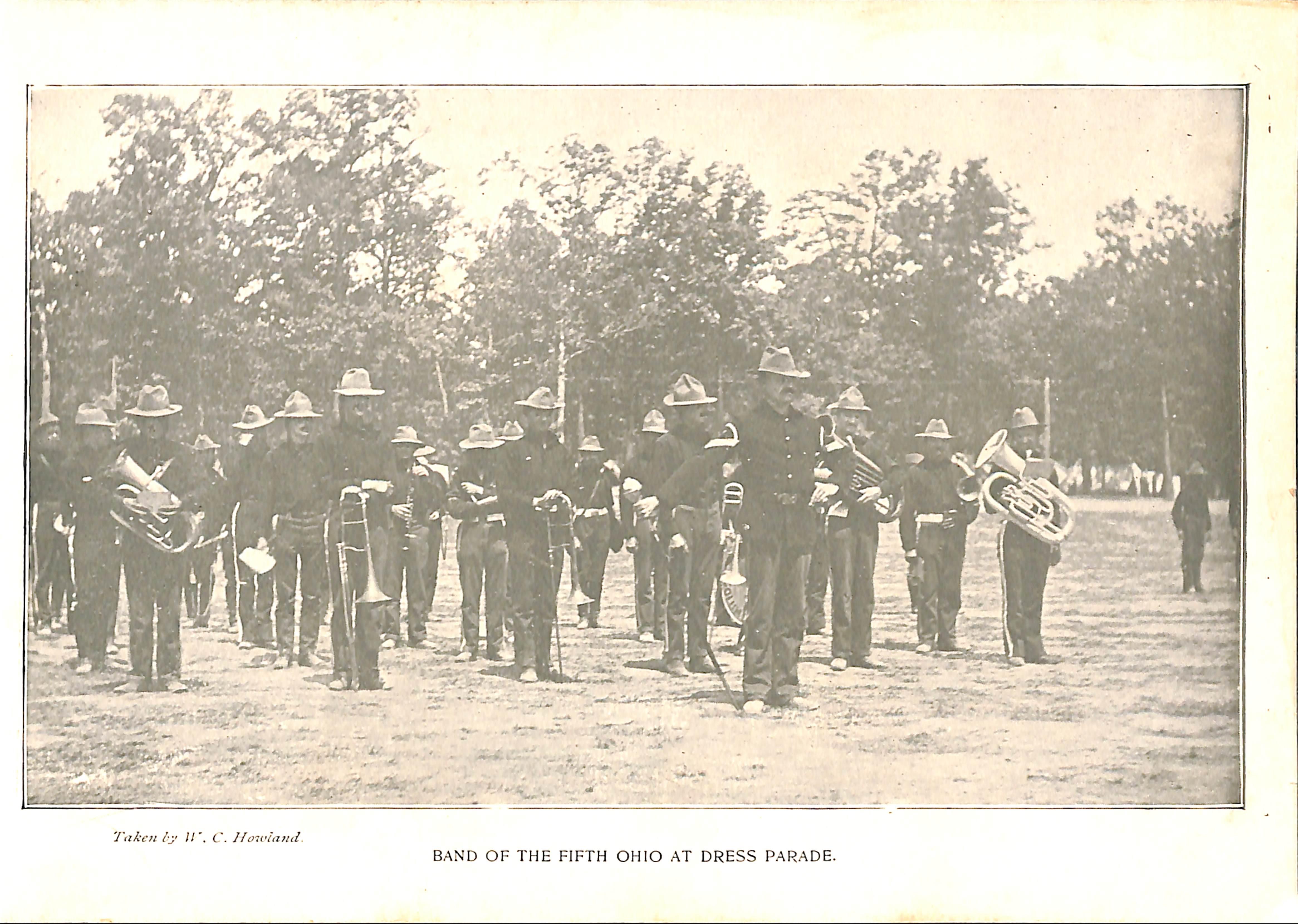
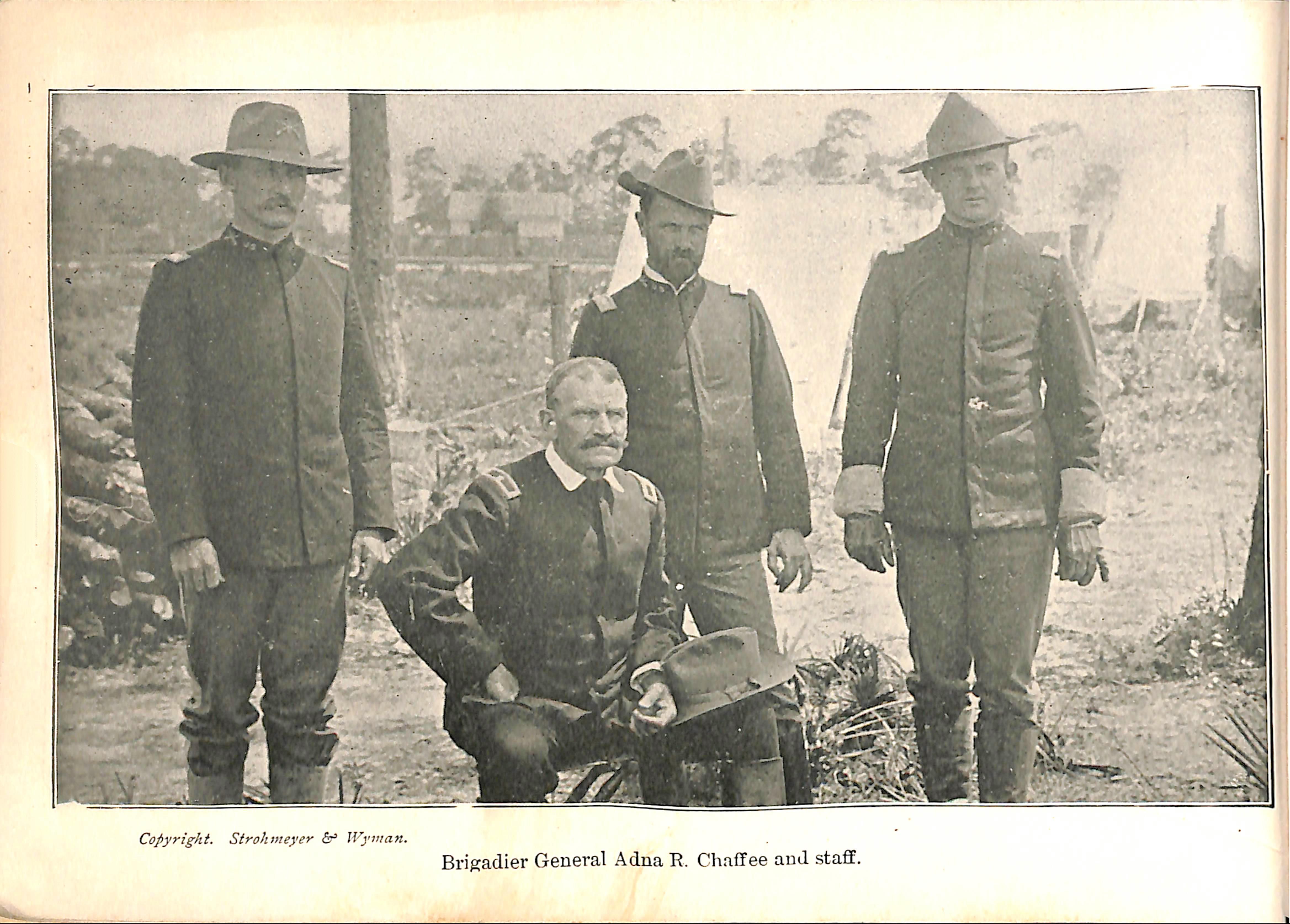

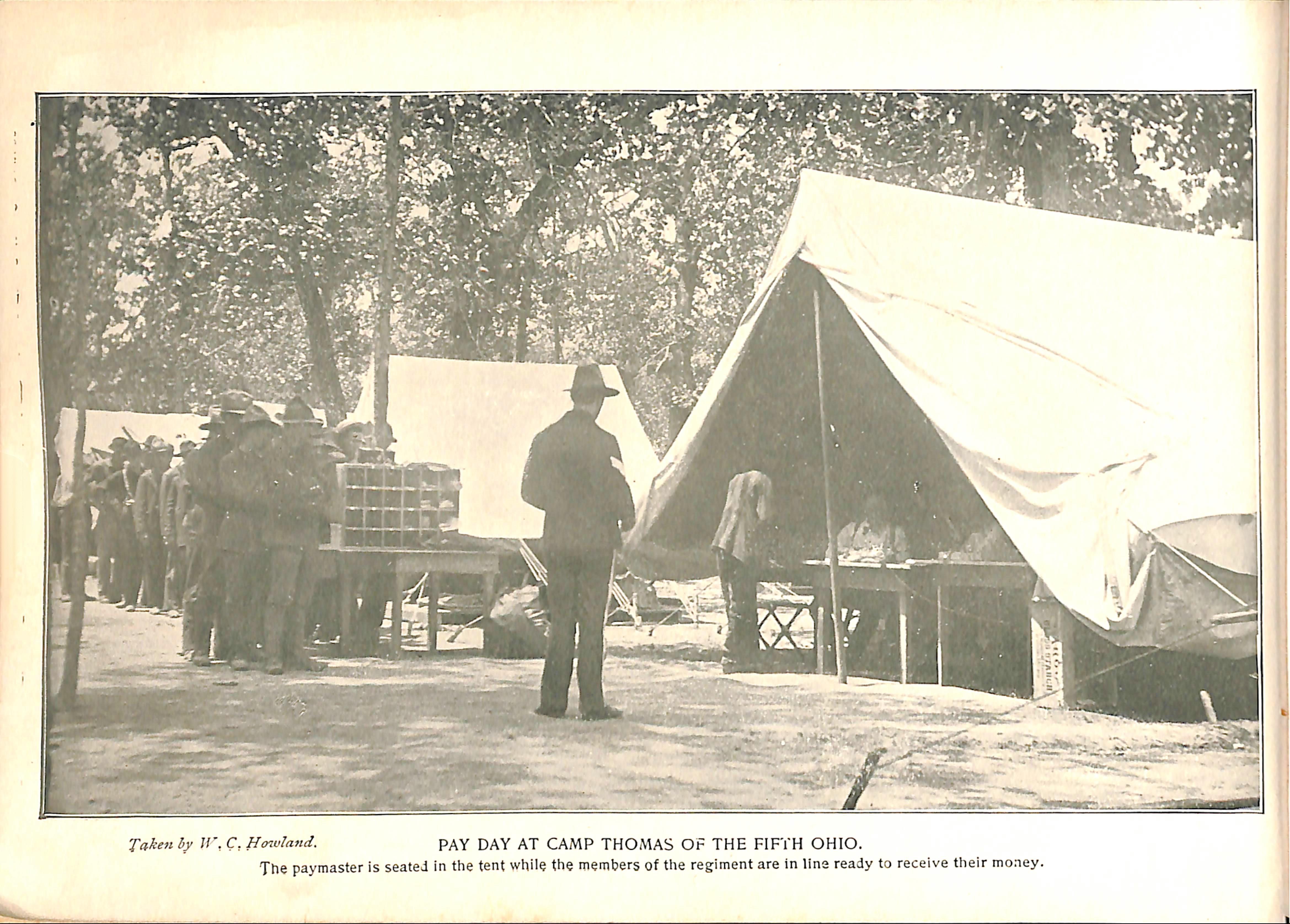 i-vJ-I-íTS
Takenhj, ]V,C:H<nvland. pAY DAY AT CAMP THOMAS OF THE FIFVH OHIO.
Tne paymaster is seateJ ¡n the tent while the members of the regiment are In lins ready to receive their money.
i-vJ-I-íTS
Takenhj, ]V,C:H<nvland. pAY DAY AT CAMP THOMAS OF THE FIFVH OHIO.
Tne paymaster is seateJ ¡n the tent while the members of the regiment are In lins ready to receive their money.
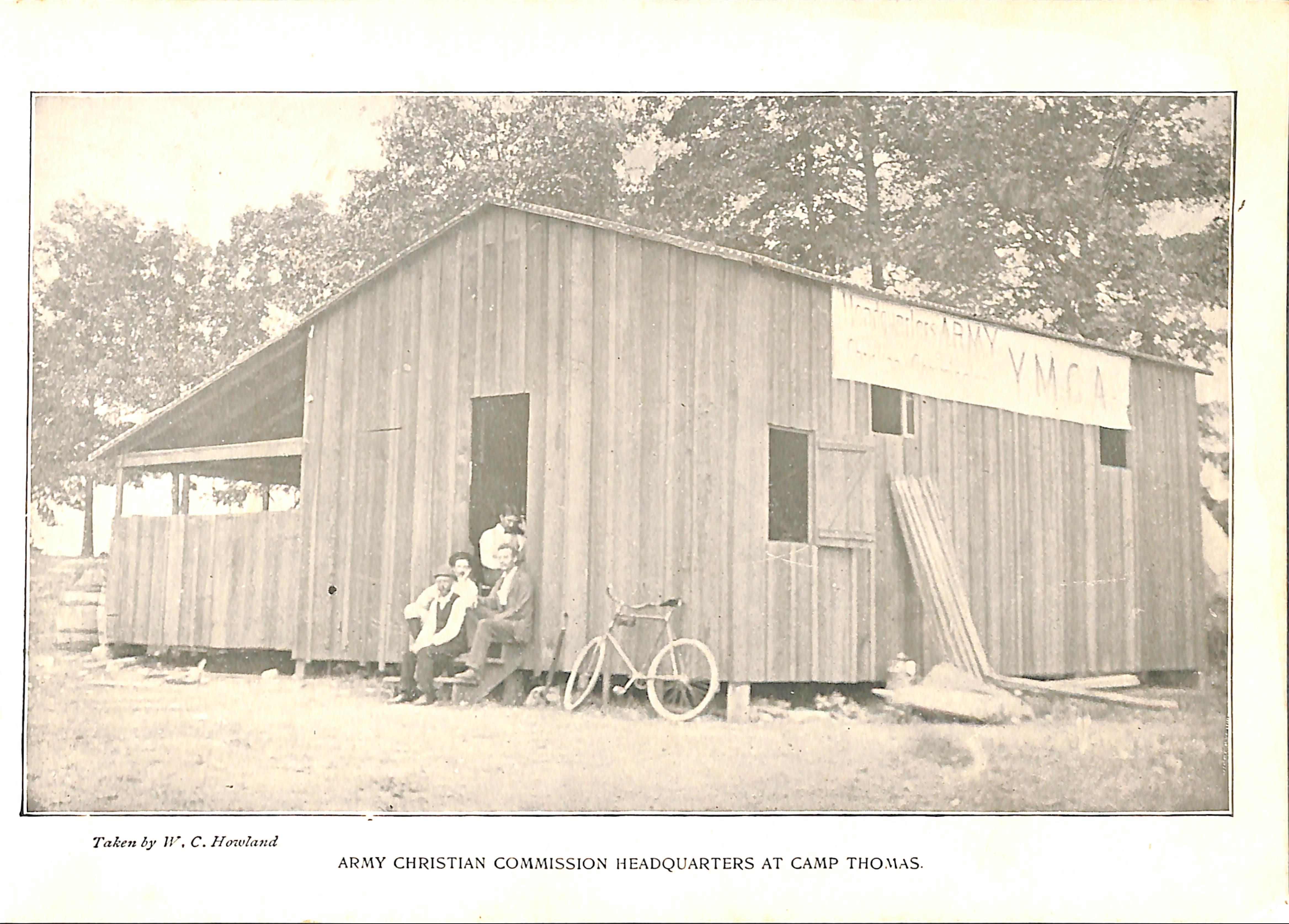
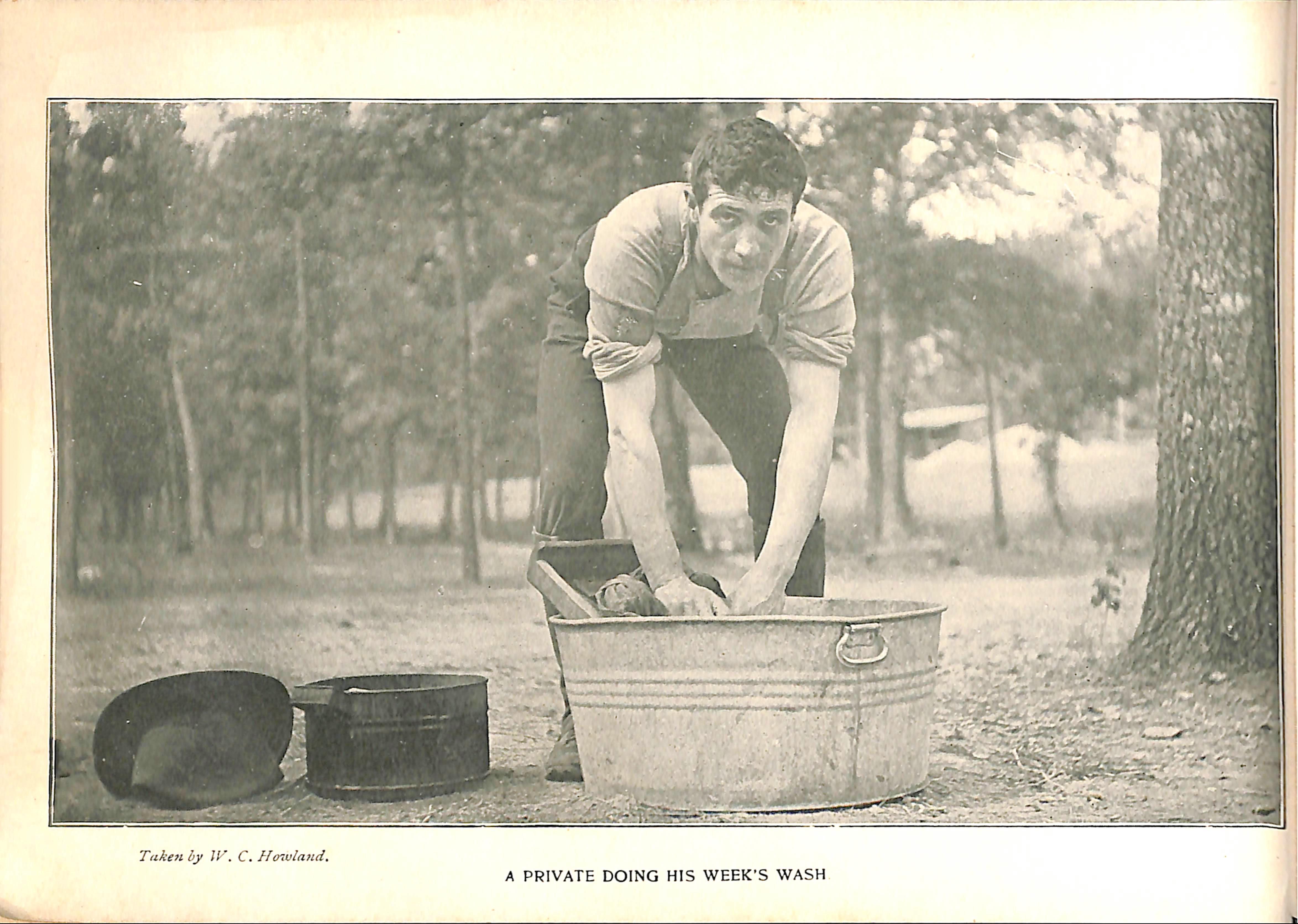
POST OFFICE AT CHICKAMAUGA.
Where over one hundred thousand letters were handled each day.

Copyright. Strohmeyer &= Wyman.
ilajor-General Wheeler, Coloael Wood, Lieut.-Colonel Eoosevelt, Major Brodie, Major Dunn and Chaplaiu Brown.

 Taken by Jf. C. l¡oT.vÍand, COLONEL GRIGSBY'S HEADQUARTERS.
The Colonel ís seated in a chair and two members of hls staff are standinjr in front of the tent. This regiment is known as the Third United States Volunteer Cavalr>'. made up of cowboys from the Black Hills.
Taken by Jf. C. l¡oT.vÍand, COLONEL GRIGSBY'S HEADQUARTERS.
The Colonel ís seated in a chair and two members of hls staff are standinjr in front of the tent. This regiment is known as the Third United States Volunteer Cavalr>'. made up of cowboys from the Black Hills.

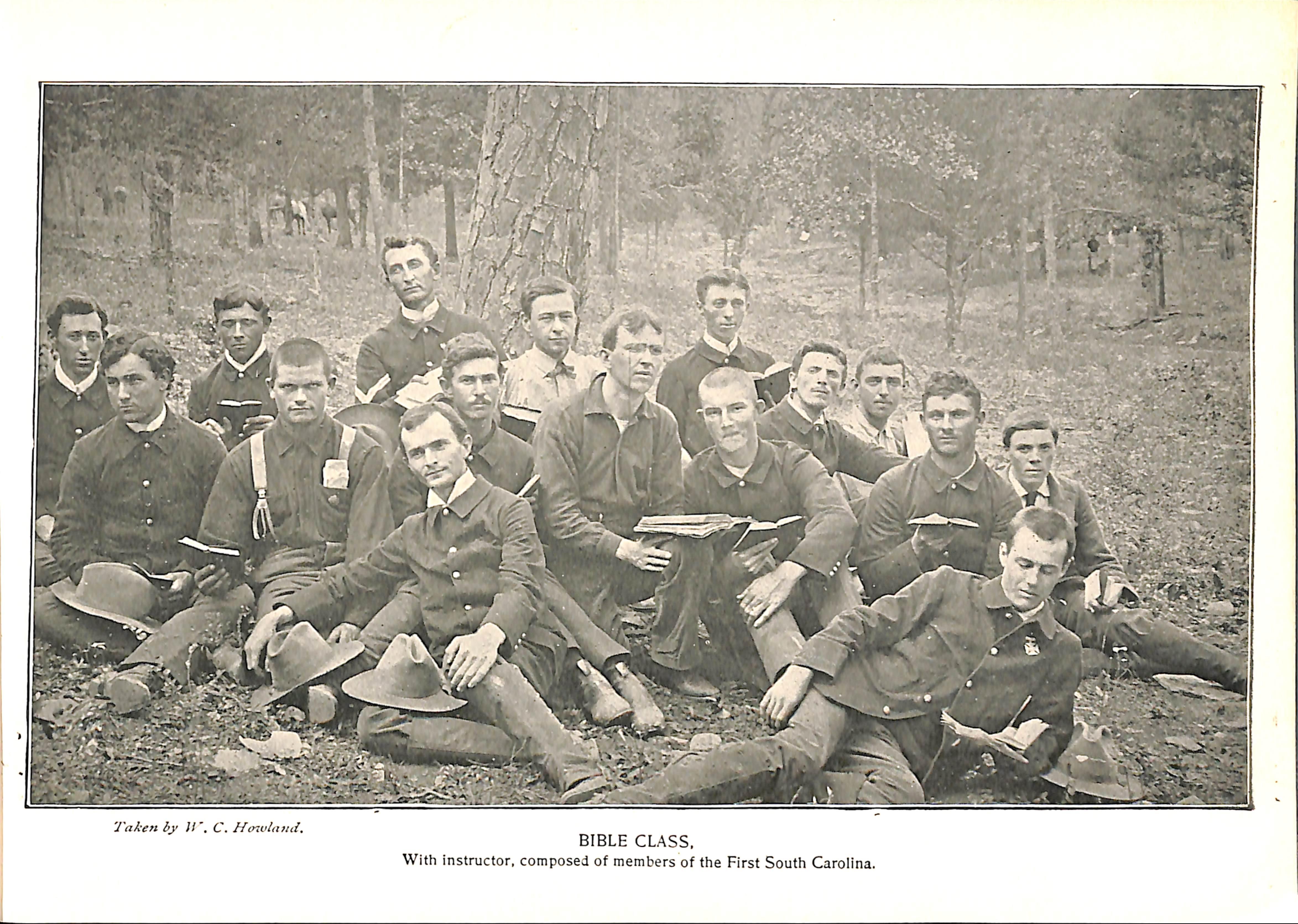 STaken by //'. C. Hcnvlnuil, BIBLE CLASS, With instructor, composed of members of the First South Carolina.
STaken by //'. C. Hcnvlnuil, BIBLE CLASS, With instructor, composed of members of the First South Carolina.

 Cof'yright. Strohmeyer if IVyman. 'Roiigh Riders"fiUing belts with cartridges.
Cof'yright. Strohmeyer if IVyman. 'Roiigh Riders"fiUing belts with cartridges.
First photograph taken after death.


 To-keti bv // C. ib t/zx/niuu
GOVERNOR HASTINGS AND HIS STAFF. OF PENNSYLVANIA. Shaking: hands \v;th the members of the Thirteenth Pennsylvania Reglment before they left for the front. The men were standing; up in dress parade ín their company streets.
To-keti bv // C. ib t/zx/niuu
GOVERNOR HASTINGS AND HIS STAFF. OF PENNSYLVANIA. Shaking: hands \v;th the members of the Thirteenth Pennsylvania Reglment before they left for the front. The men were standing; up in dress parade ín their company streets.




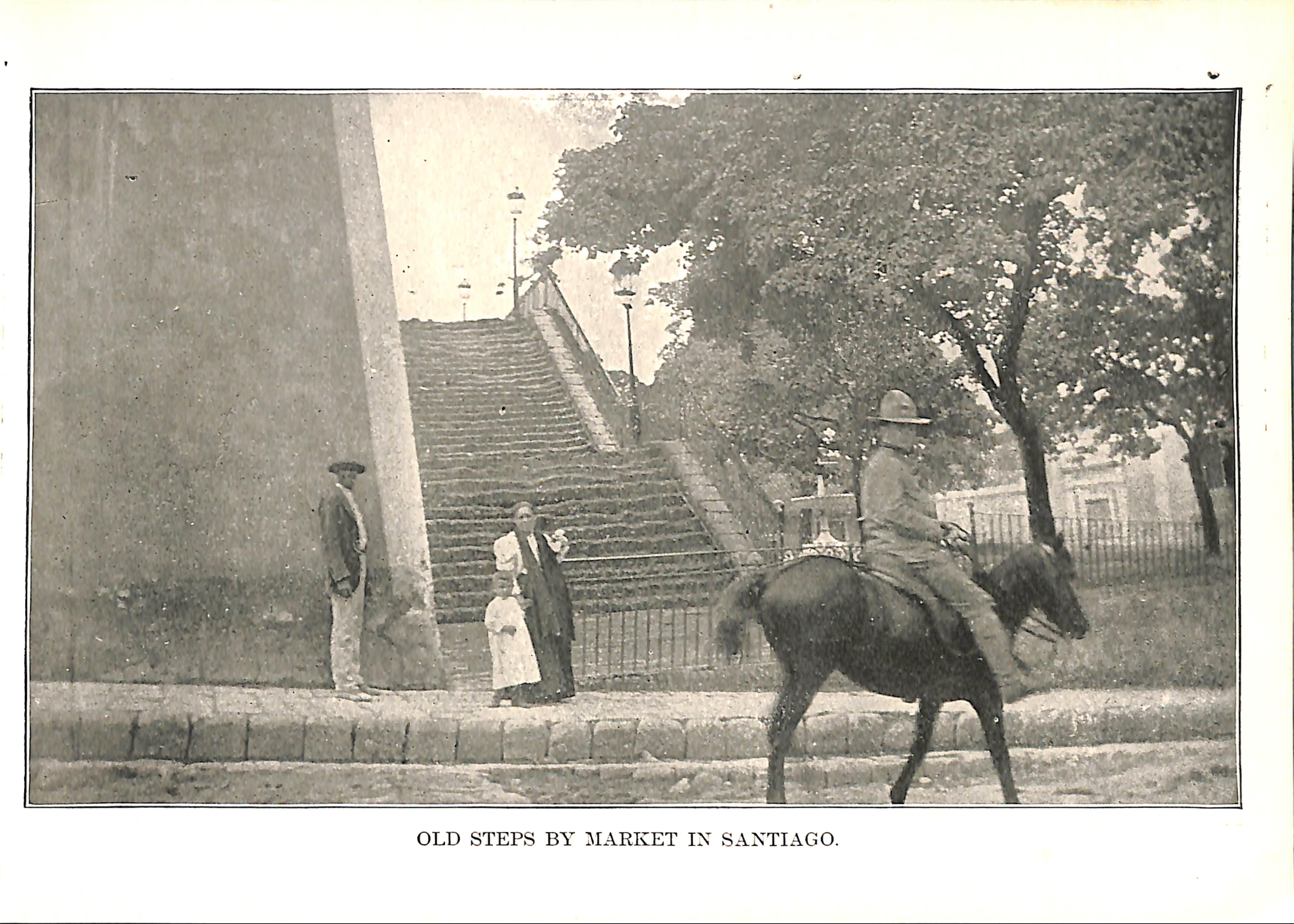 OLD STEPS BY JIARKET IX SAXTIAGO.
OLD STEPS BY JIARKET IX SAXTIAGO.

Takcn by /K C.}¡<yivland.
VIEW LOOICING FORWARD FROM THE BRIDGE OF THE "NIAGARA* While off the coast of Cuba. The gun crew is ¡n the bow.

 Cotyrieht. Strahmeyer IVyman.
Major-General Joseph Wheeler and stafE.
Cotyrieht. Strahmeyer IVyman.
Major-General Joseph Wheeler and stafE.
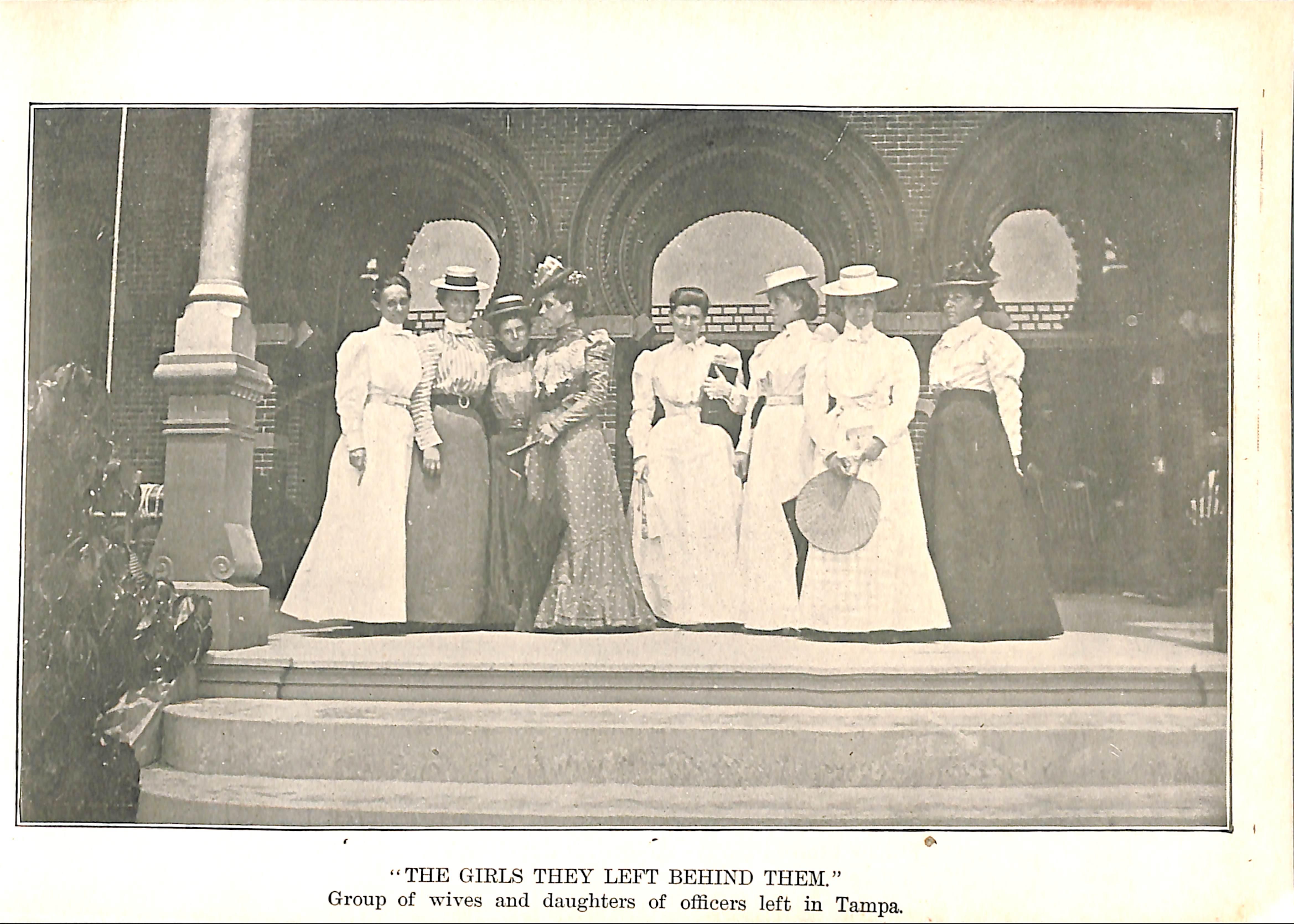






'REINE MERCEDES.'
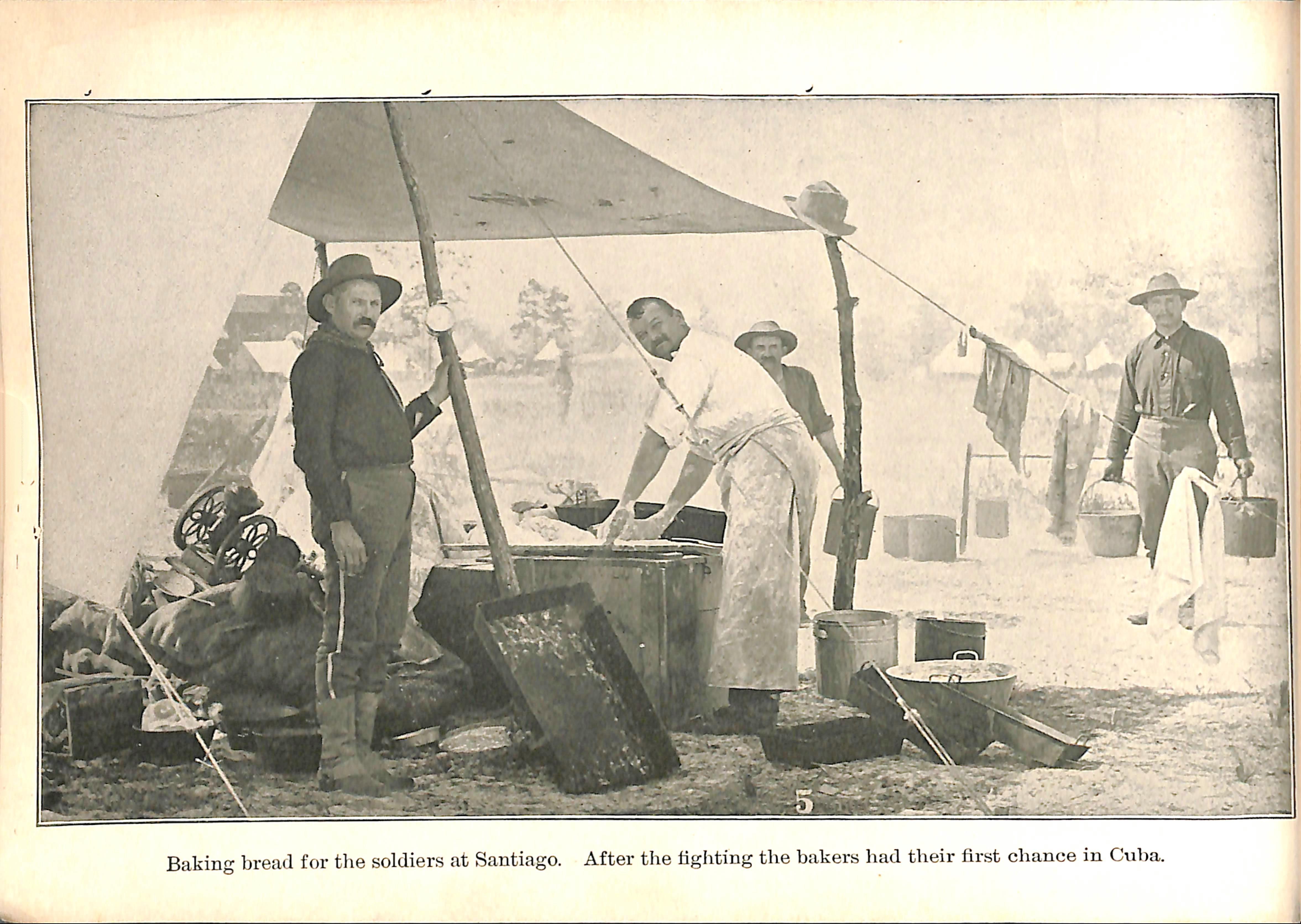 Baking bread for the soldiers at Santiago. After tlie tíghtíng the bakers had their first chance in Cuba.
Baking bread for the soldiers at Santiago. After tlie tíghtíng the bakers had their first chance in Cuba.
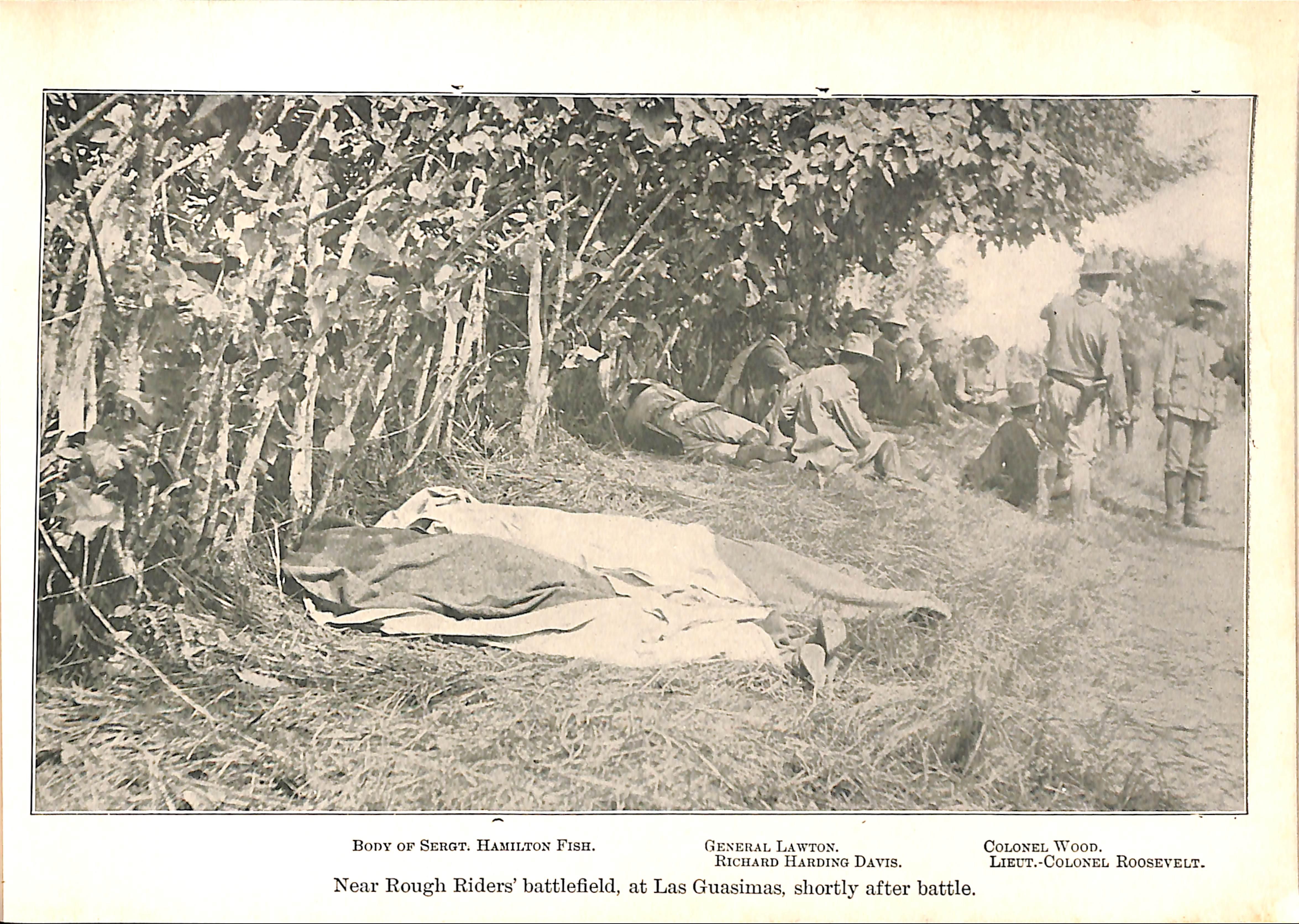 Body of SergTí Hamilton Fish.
General Lawton. Richard Harding DAns. COLONEL WOOD. Liedt.-Colonel Eoosevelt.
Near Rough Riders' battlefleld, at Las Guásimas, sliortiy after battle.
Body of SergTí Hamilton Fish.
General Lawton. Richard Harding DAns. COLONEL WOOD. Liedt.-Colonel Eoosevelt.
Near Rough Riders' battlefleld, at Las Guásimas, sliortiy after battle.
IHOUSE OF REPRESENTATIVES, WASHINGTON, D. C.
Where declaration of war was made aud the peace treaty ratifled
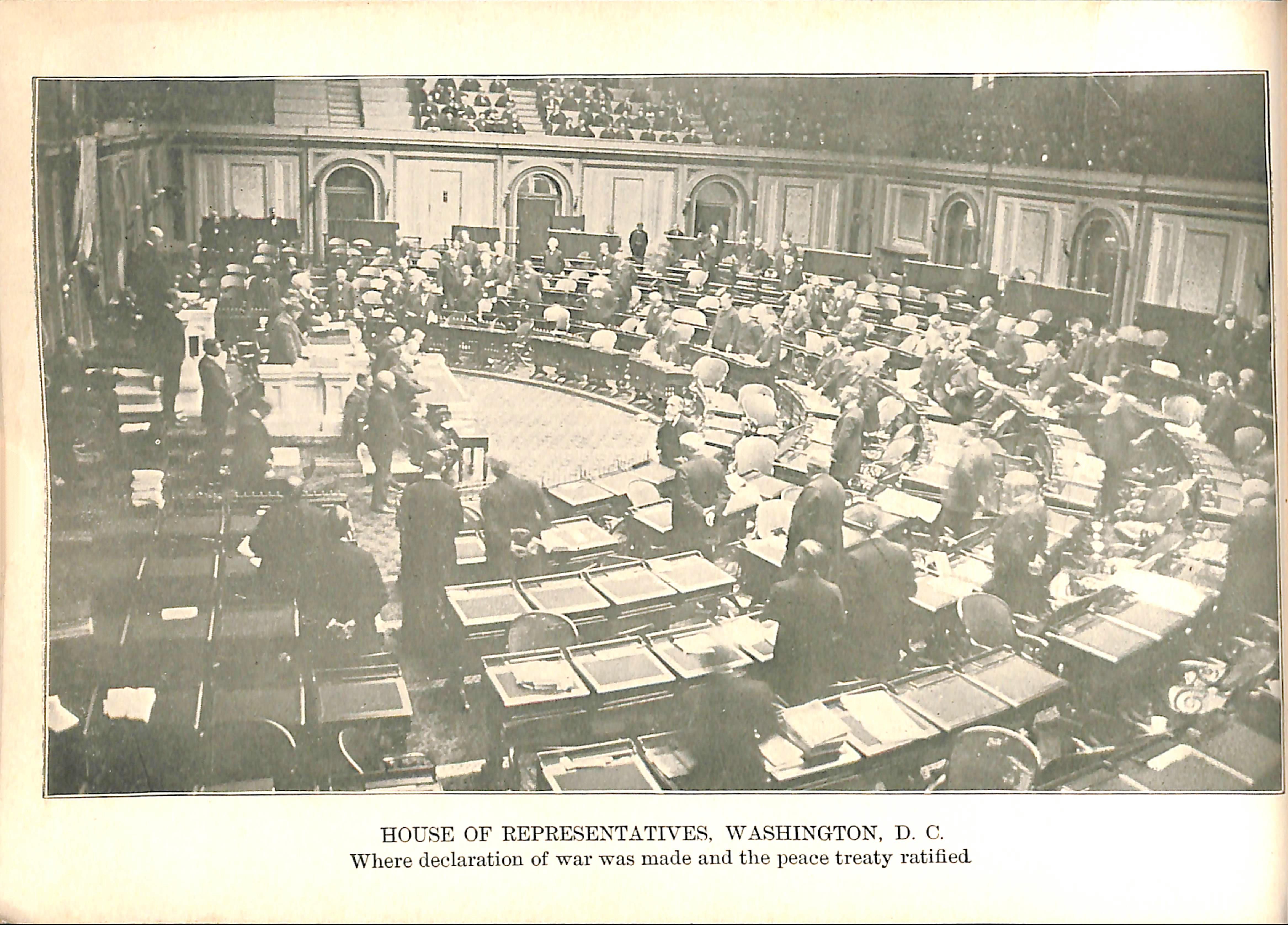
 STATL'E OF QUEEN ISABELLA IN THE CENTRAL PARQUE, HAVANA.
STATL'E OF QUEEN ISABELLA IN THE CENTRAL PARQUE, HAVANA.
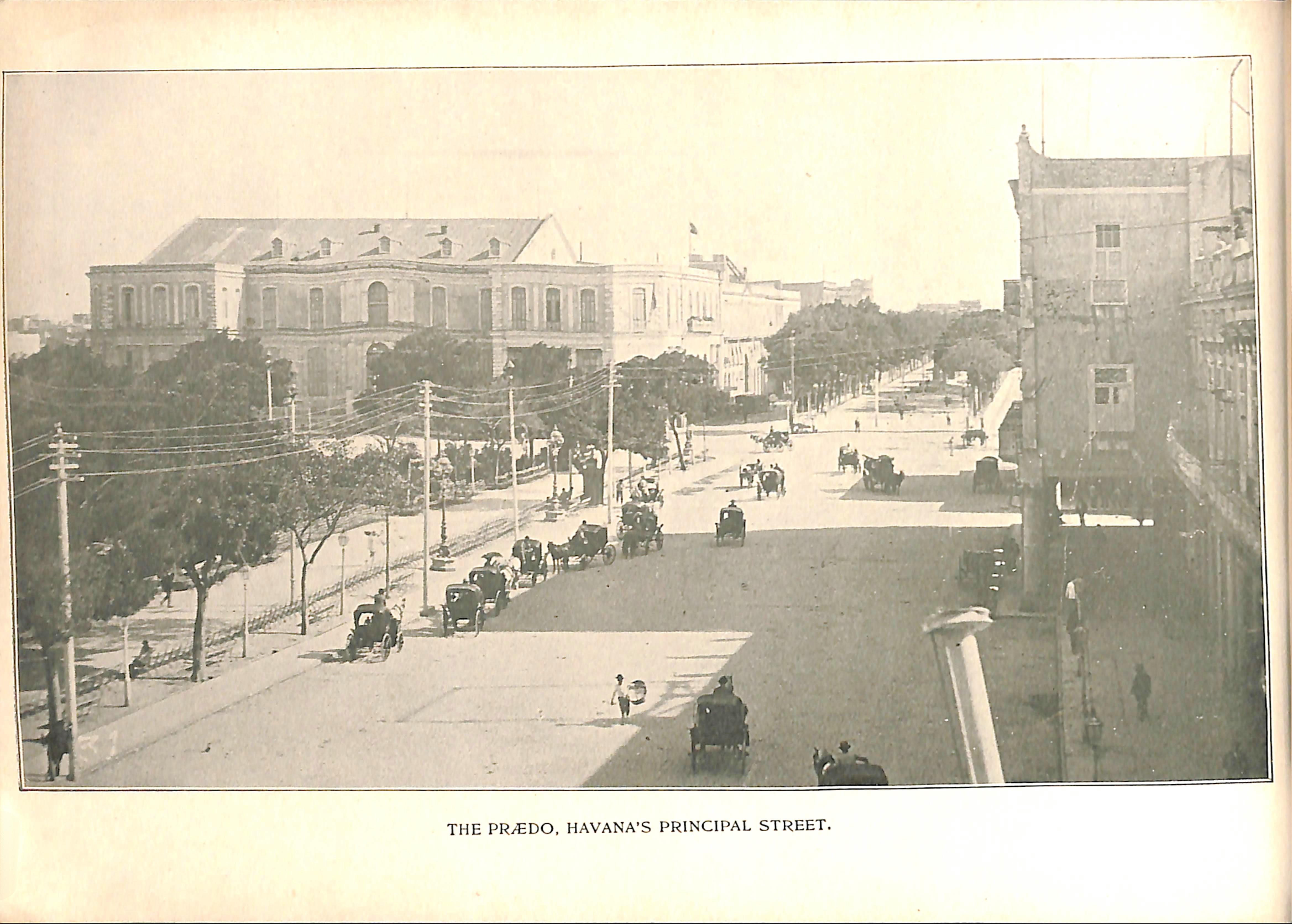
TYPICAL FOUR-LEGGED BURDEN BEARER IN CUBA.

CABANAS FORTRESS.


Copyright. Strohmeyer Wyman. Inspection—"Rough Riders."


Copyright, Sirohmeyer Gf IVyman.
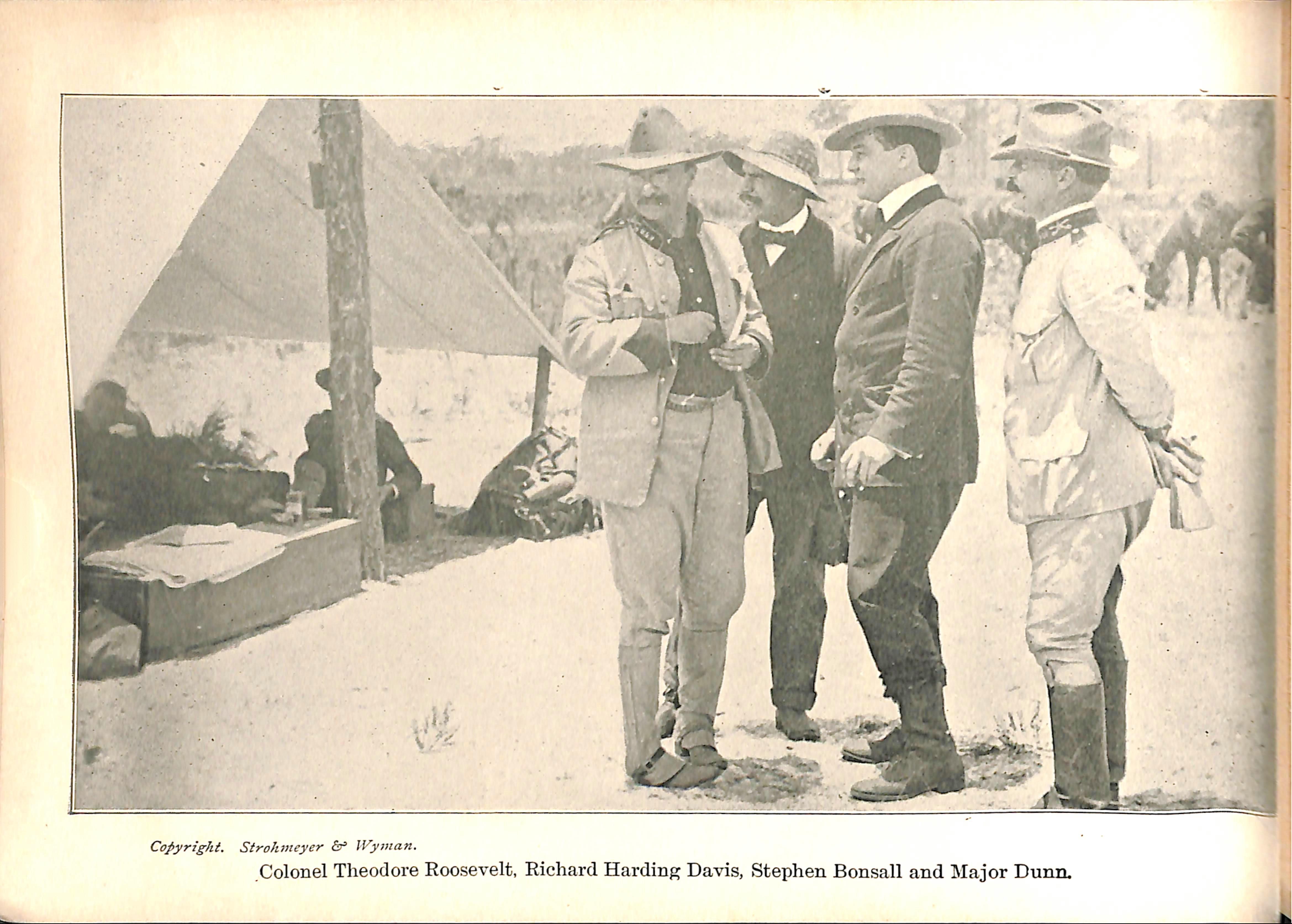 Colonel Theodore Roosevelt, Richard Harding Davis, Stephen Bonsall and Major Dunn.
Colonel Theodore Roosevelt, Richard Harding Davis, Stephen Bonsall and Major Dunn.
MNUESES' PAELOE, VANDEEBILT.

Last meal before striking camp to begin embarkation for Cuba or elsewhere. In the camp of tlie Fiv.st Ohio.

Copyright. ■ Sirohvicycr «Sr* VVyinan.
Troop "D " of the " Rougli Riders," as they went to Cuba.

Second Massaclmsetts Regiment going aboard transports at Tampa. Numbers eighteen aud seven show how transports are distiuguished.
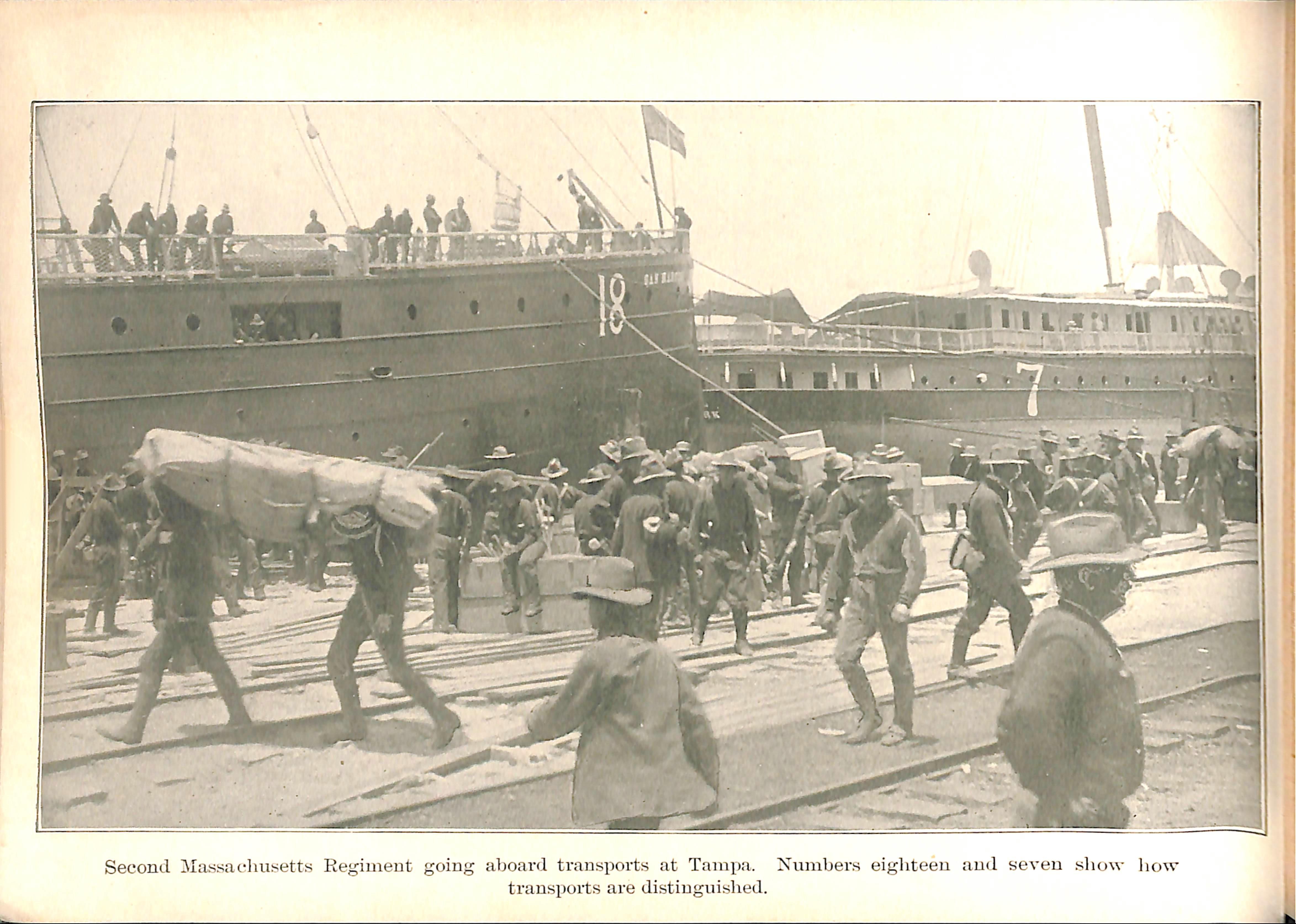


Copyright. Strohjneyer ¿r* ÍVyvian.
 Lieutenant Tiffauy, Captain Woodbuiy Kane, Majoi* Dunn, Major Jenkins, Lieutenant Devereaux.
Lieutenant Tiffauy, Captain Woodbuiy Kane, Majoi* Dunn, Major Jenkins, Lieutenant Devereaux.

■
Cojtyright. Strohineyer ^ Jl yman.
Major-Goneral Shafter, comniauding the first especlition to Cuba



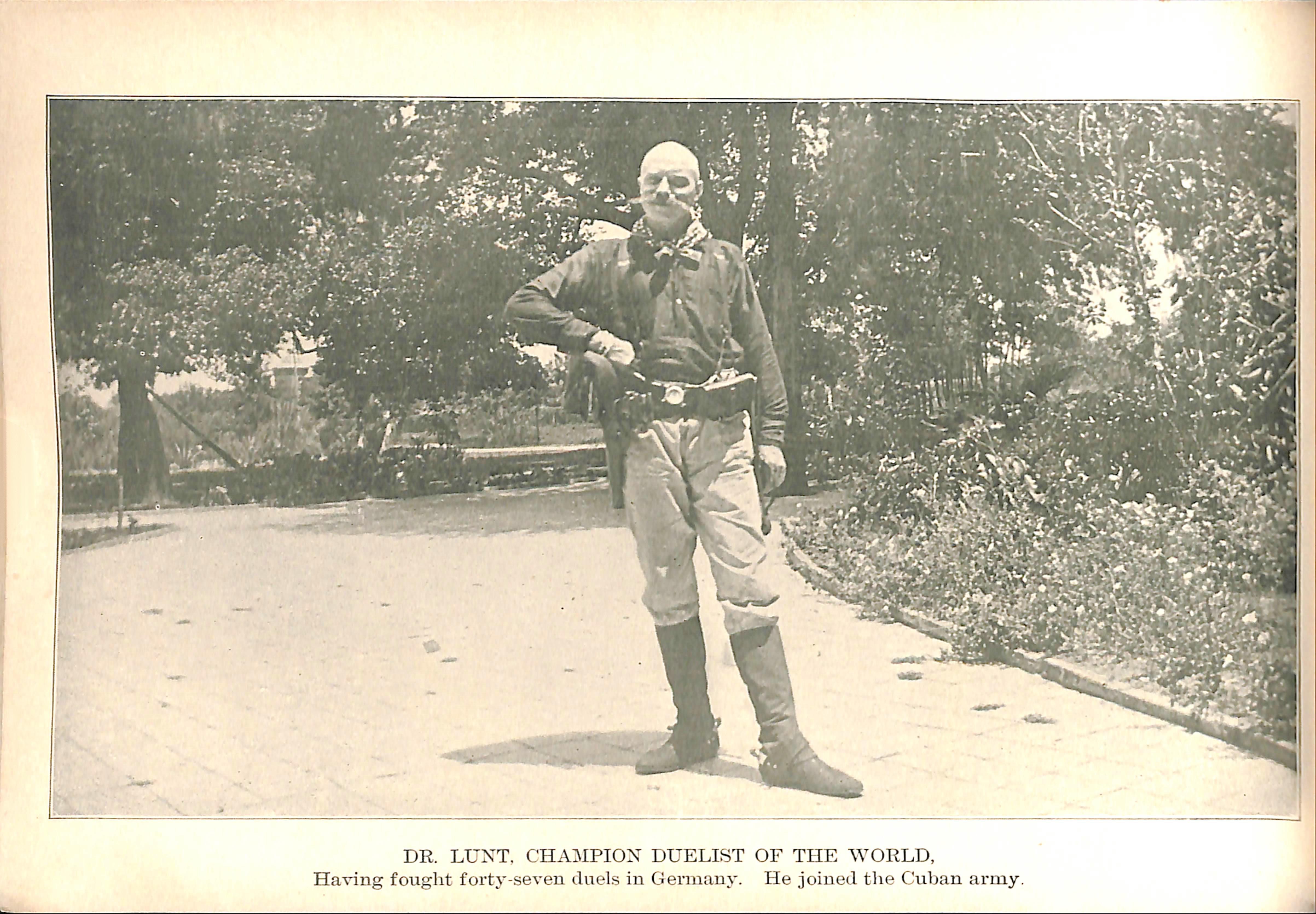
Copyright. Sirohvieyer ^ ll'yjiiafi.
Chaplain Brown, of the '•Rough Riders," preaching to the regiment

Copyright. Strohmeyer df Wyman.
English, Russian, Germán, Austrian, Japanese, Swedish military attaches, with our army at Santiago de Cuba.

THE INTERIOR GE A PORTO RICAN THEATRE. The Spaniards are generous patrons of the stage and have comfortable theatres in nearly every city.

A TYPICAL NATIVE PLAZA.
The Spanish-American. like the Spaniard, cannot live withouthÍ5 plaza, aid the enjoyment he receives from the promenades ¡n the shaded walks. while the music echoes through the trees. the {jossip with his neighbors and relatives. proves to the American heart that there is good reason for his seniiment. It wouldn't be exactly correct to say that all Porto Rican plazas or parks are allke, but ¡t would be very nearly so.

THE CITY OF MAYAGUEZ.
This heautiful city is situated in the west of Porto Rico cióse to the channel between tlie islanJ and Havti. It Is the center of a lartre and rrosperous colfee district and has an extensiva commerce. The cunous construction of the houses is well shown, The'older roofs are covered with rounded tilefand sowe »-,tn hricks set in cement. The newer ones are covered with tlat térra cotta tiles, or else with sheets of ^alvanized corrugated iroi^^ rounded tiles and
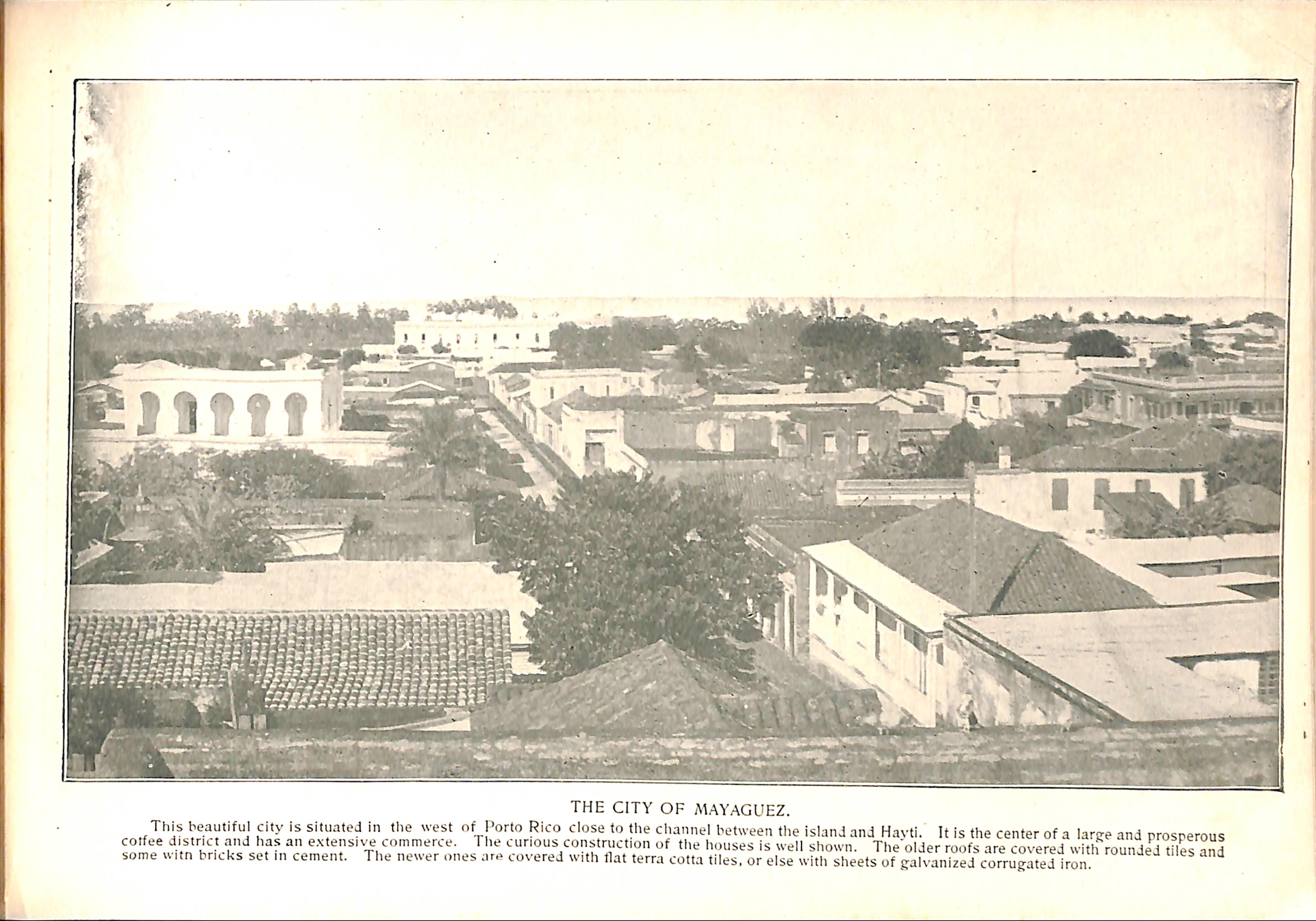
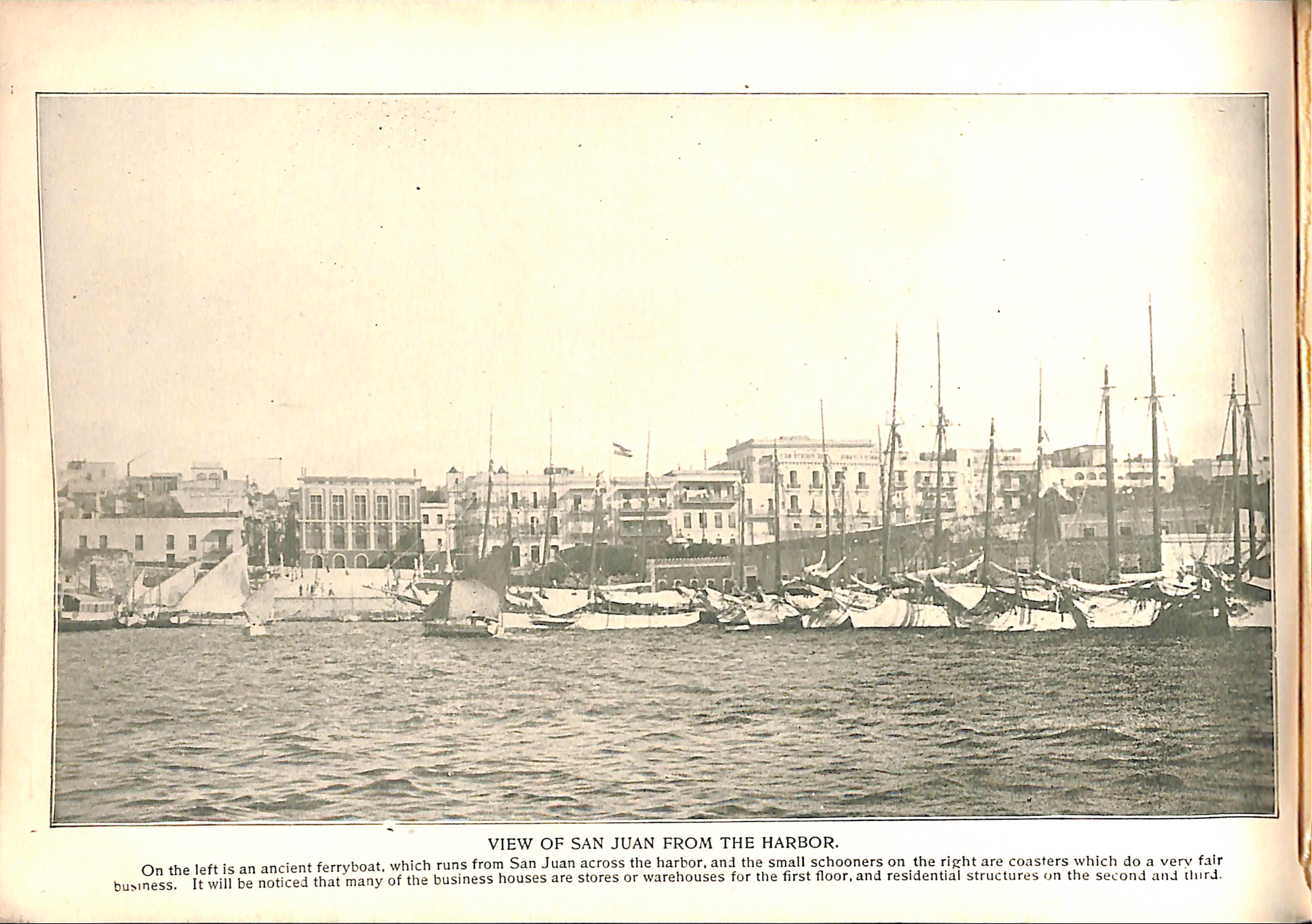
A PORTO RICAN HOUSE PARTY REPRESENTING SOCIAL LIFE.
.K Porto Rico is well wortli emulating. The members of a church. a club,a neiRhborhood dique orevenof a biírfamilv bein? excectionallv f °í , ''' """í «reated wi.h the síme respect as anoid rn?and t^hfoUst tZaí e g: a>s the dictator and oueen. Ttiess deep, cooi verandas are used as iiving rooms the yearthrough and are extremeiy coitifortabie.
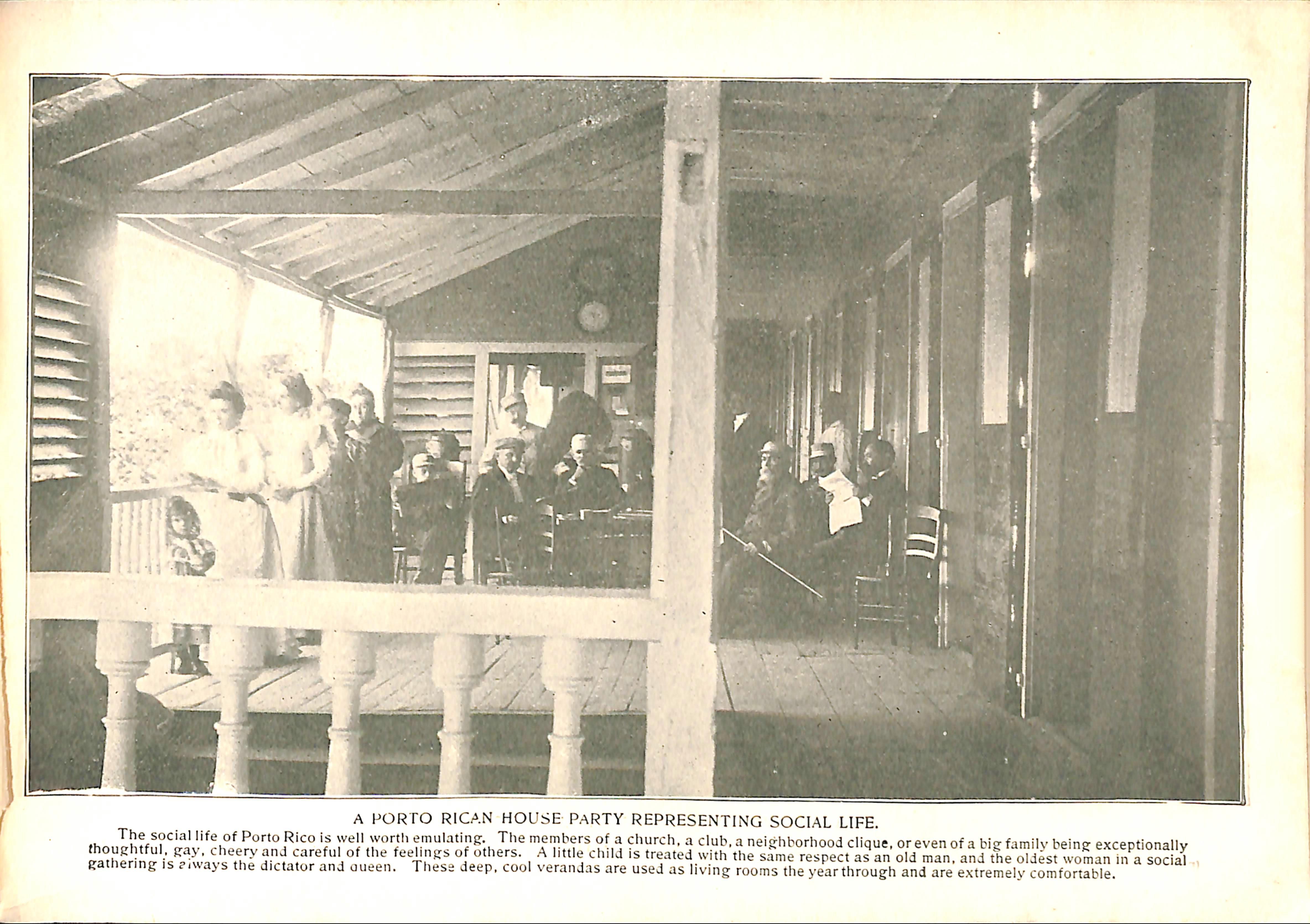
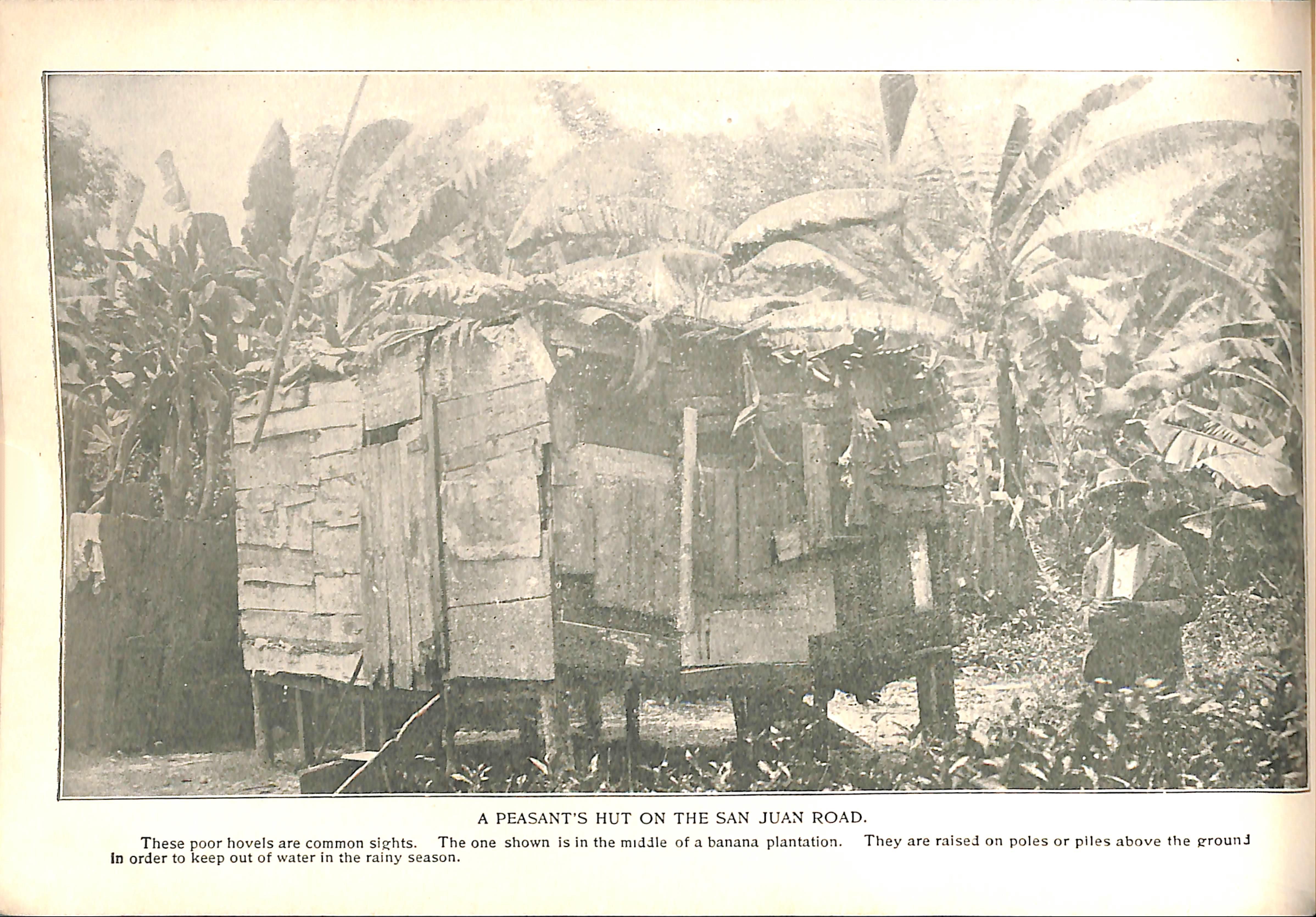
These poor hovels are common si^hts. The one shown Is in the middle of a banana plantation. In order to keep out of water ¡n the rainy season.
They are raísed on potes or piles above the g-rounJ
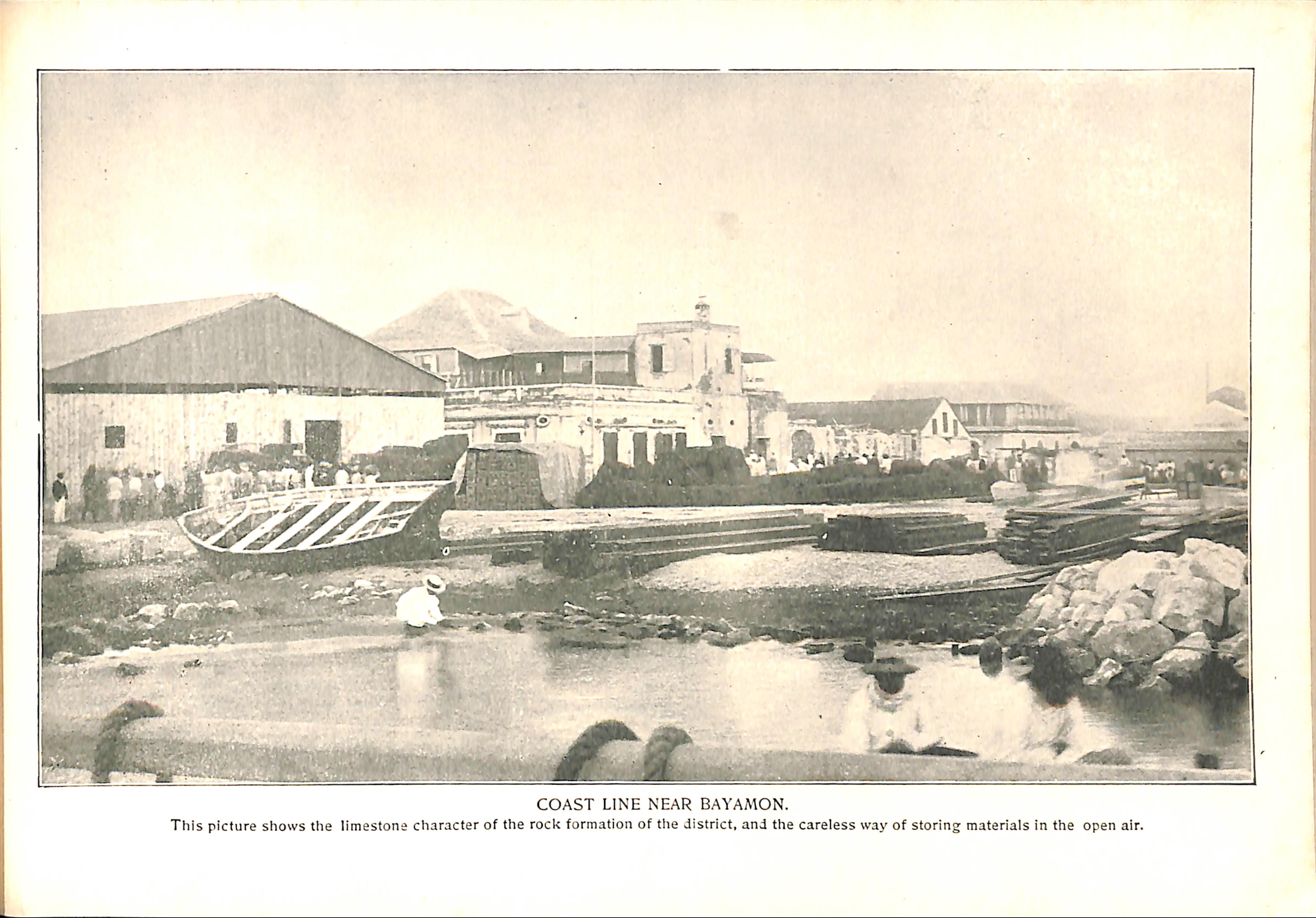 COAST LINE NEAR BAYAMON.
This picture shows the limestone character of the rock formation of the district, and the careless way of storing materials in the open air.
COAST LINE NEAR BAYAMON.
This picture shows the limestone character of the rock formation of the district, and the careless way of storing materials in the open air.

The laundries of Porto Rico are all open-air institutinns. the power Peing supplied by muscular half-breeds or colorad women. The dress of the washerwomen is very simple, coiisisti.ií; of a handkerchief or baiiJana iied ovar tlie heaJ so as lo cover nearly all the halr, and a gown which comes from the tiííck nearlv to the ankies.
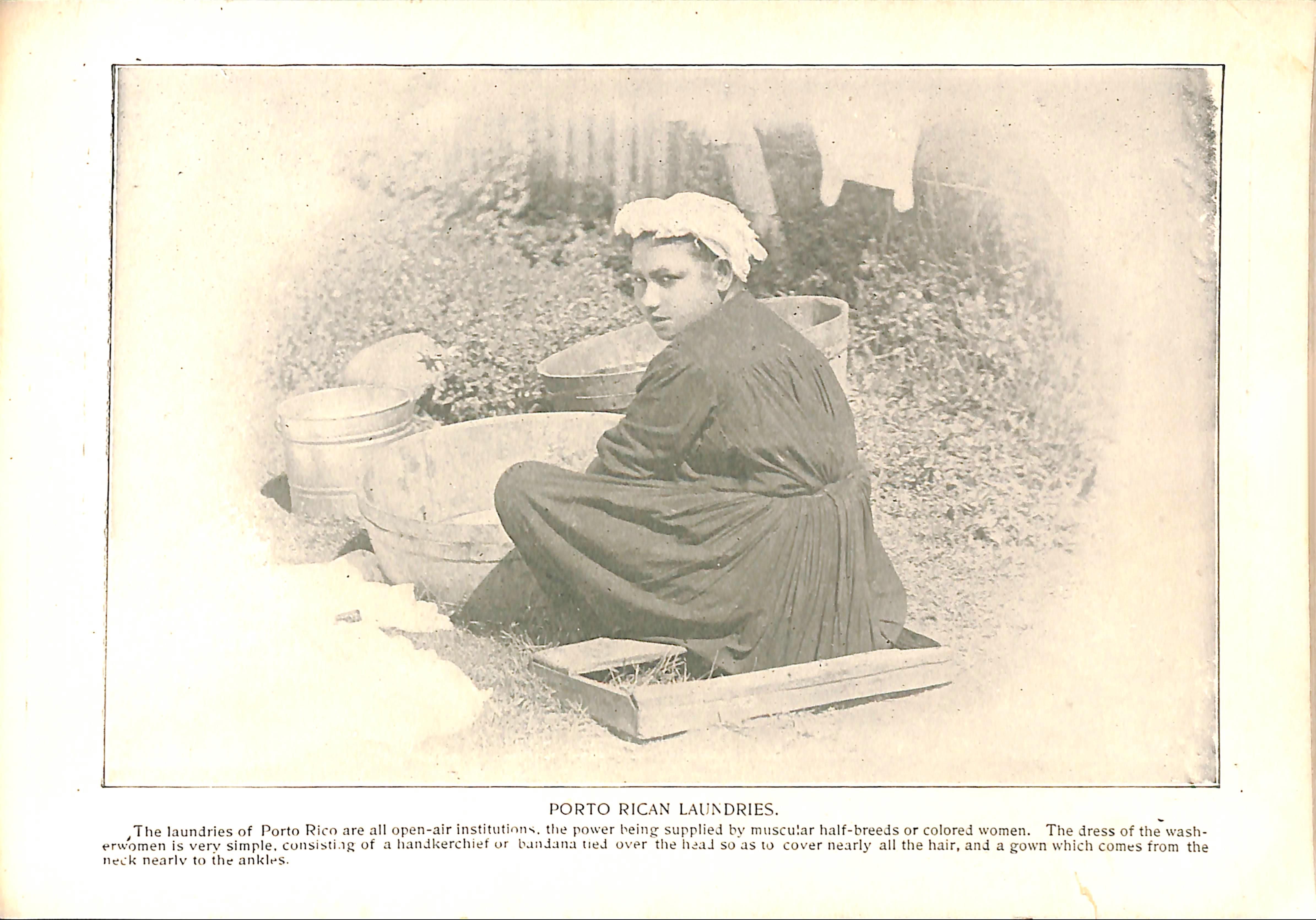
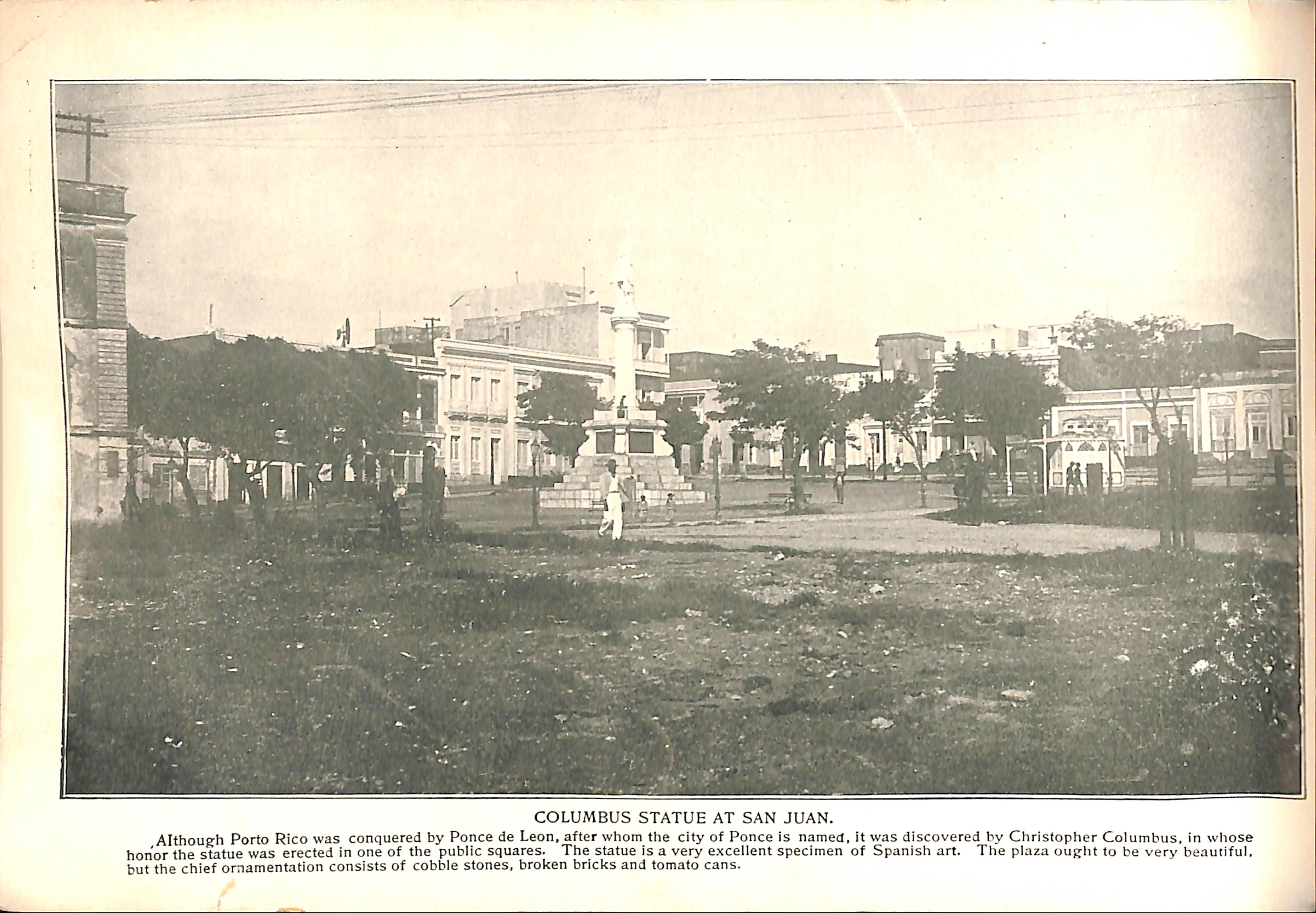 COLUMBUS STATUE AT SAN JUAN.
Althouffh Porto Rico was conquered by Ponce de León, after whom the city of Ponce is named, It was discovered by Christopher Columbus, in whose honor the statue was erected in one of the public squares. The statue ís a very excellent specimen of Spanish art. The plaza ought to be very beautiful. but the chief ornamentation consists of cobble stones, broken bricks and tomato cans.
COLUMBUS STATUE AT SAN JUAN.
Althouffh Porto Rico was conquered by Ponce de León, after whom the city of Ponce is named, It was discovered by Christopher Columbus, in whose honor the statue was erected in one of the public squares. The statue ís a very excellent specimen of Spanish art. The plaza ought to be very beautiful. but the chief ornamentation consists of cobble stones, broken bricks and tomato cans.
Porto Rico is a commonwealth where caste has been a monarch. Therc are the very rich and the very poor. Then there is the upper middle class, which is made up oi half castes who have become fairly well educated, and hqld commercial positions of trust. There is the lower middle class, composed of natives who are of Carib descent - negro and white blood, and negro and Spanish blood. It is this latter class which the picture well represents.

COFFEE-DRYING PLOT NHAR MAYAGUEZ.
In progressive countries coffee is dried by Improved processes or labor-saving mach¡ner\'. in Porto Rico the same method is employeJ that has been i in Arabia from time immemorial. A piece of level ground is paved with fíat stones or else covered with cement, with a slight wall arounJ the eiids. The coffee is then dumped uponthisand made level by a wooden instrument shaped like a snow-scraper.
used

A REPRESENTATIVE DRAWING ROOM.
The reader can readily see the great difference in the furnishingf of a horro in our nsw culony and ¡n the United Stares bv a careful glance at the artícles employed in this photograph. Thequeerly fitted tile floor. the plain. almost ugly cañe farniture. the latticed wind.íws, looking iike aperiures in a prison cell, and the abundance of growing tropical plants.
 ;-i.iTSSF"'
^ 'HtíYrj
;-i.iTSSF"'
^ 'HtíYrj
UNITED STATES TRANSPORTE AT ANCHOR.
When the Anr^rícan transport fleet wa? rendezvoused off the Playa del Ponce it maie a very striking picture frjm the shore and looked llke a floatlng clty.
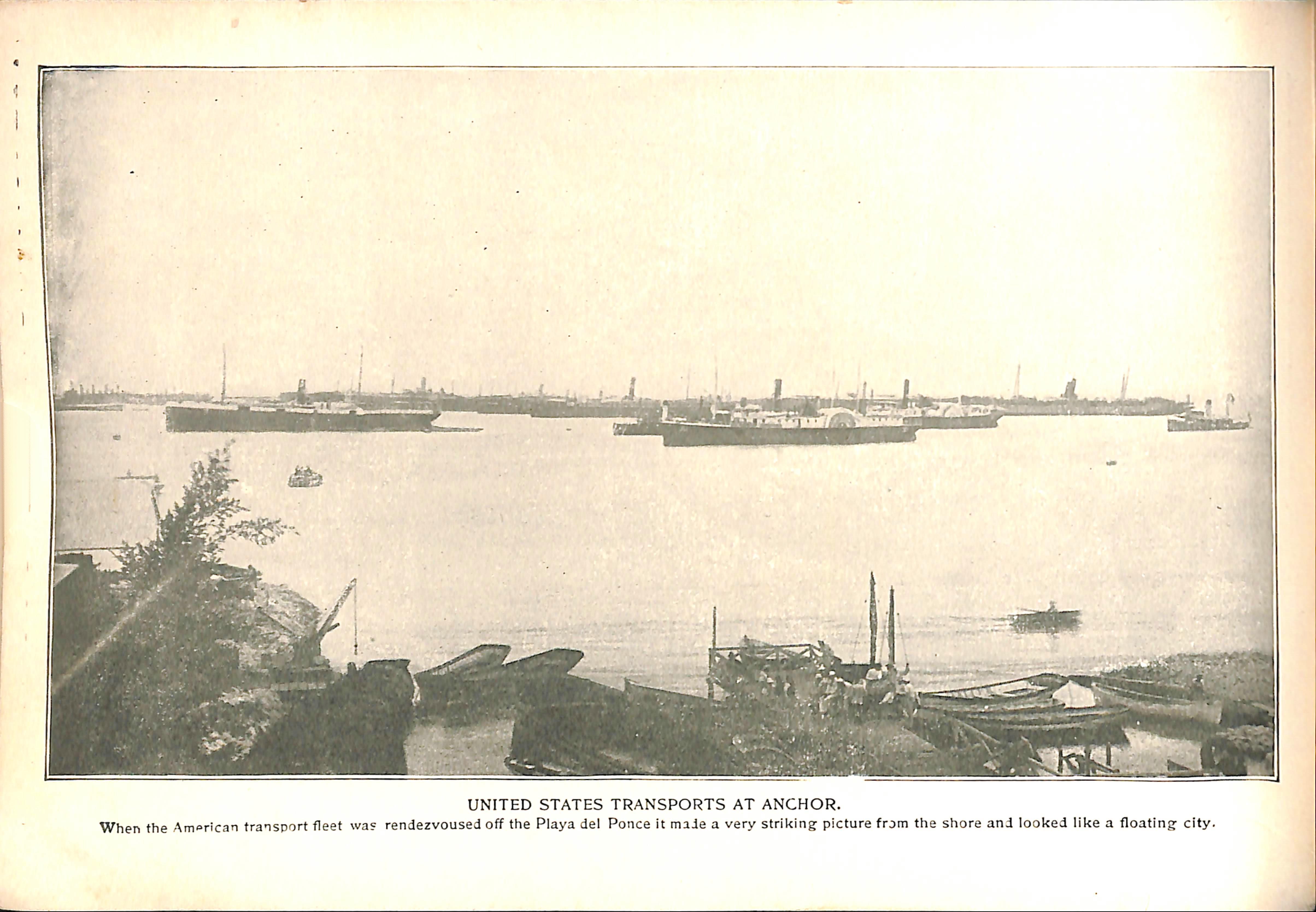

The Springs of Coamo are famous for their medicinal virtues and have been used on a large scale for that purpose for more Ihan a century. The bath* houses are large and handsome. and well equipped.

PONTOON PIER AT GUANICA.
This inc:eníous floatinj^ wharf wns built by the Amerícan engineers shortly after the disembarkation of ihe American Army. Although It looks frail and ii*^stable it is \•^ realitv quite strong, and from the time of its construction has proved of great valué to both the army during the war a id to the place since iiie Spanish evacuation.

This is the fort which was bombarded early in the war by Admiral Sampson's íleet, and which, though very old-fashioned. proved to possess jjreal stren^h. On the right is the liphthouse, on the left a watch tower, and further back a semaphore,from which fla^s are hung: during; the day to indícate the approach of the malí steamers. This ancient fort has seen many wars,- having; been attacked by the Engüsh and Dutch, as well as by the Americans.
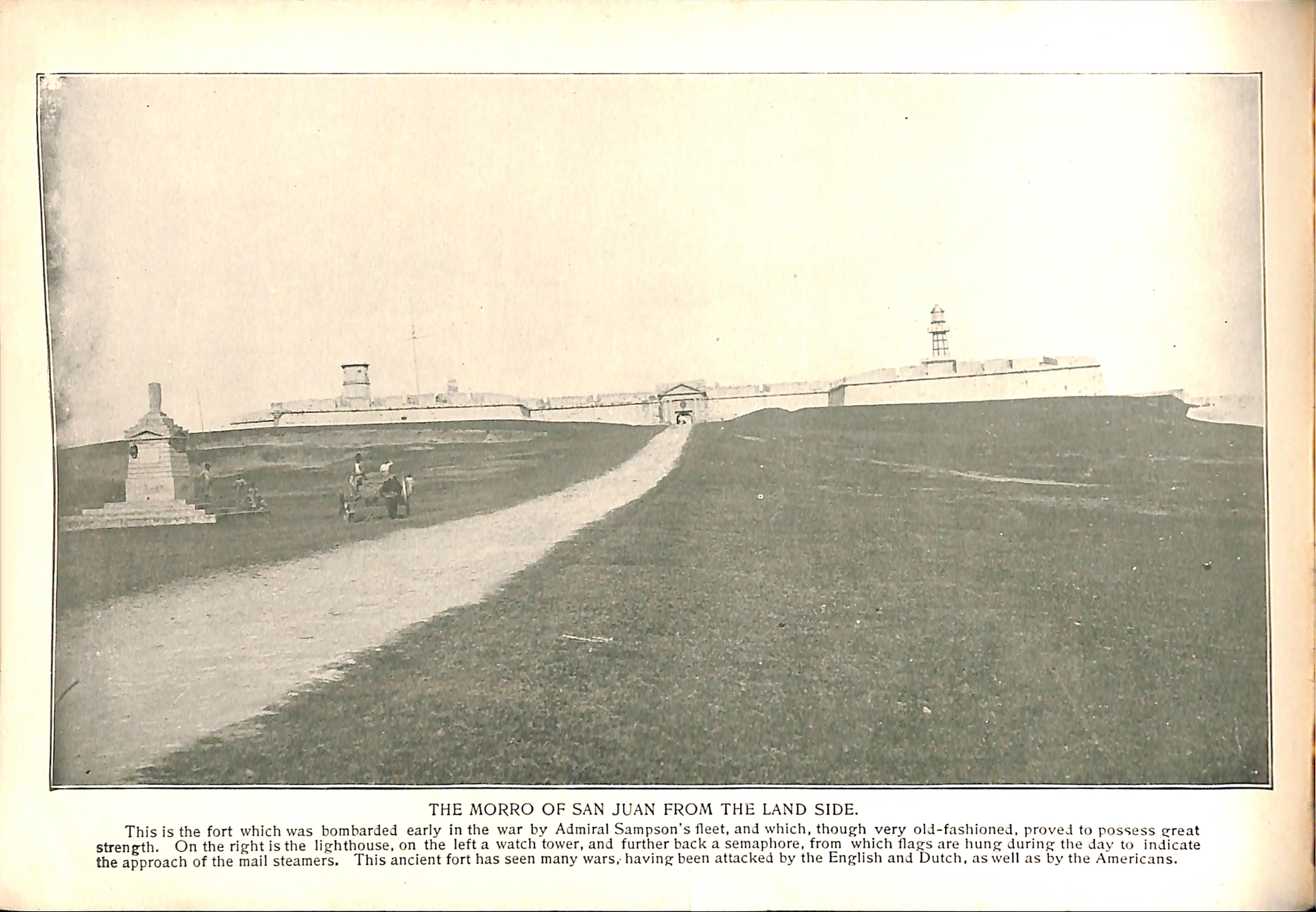
^The view shows the difference between American and Spanish administraíion. When the American troops carne alen? this wav they found the road on this hiliside a narrow brldle path not two feet wide. The engineer corps turned promptly to and in a few days, wlth the help o'f the natives, changed it intf^ a first-class thoroughfare twenty feet wide.

This beautiful valley is about twelve miles from Ponce and is famous for its fruits, flowers. vegetables, and coffee. The hei^ht of the híll keeps away the northem winds and so allows the freest g:rowth of veífetatlon. Only two houses are visible in the picture, althoug:h there are many others which are so embowered in trees and vines as to be Invisible at a short distance.

A NATIVE SALON.
 1 he Porto Rican drawinp- rooms of the well-to-do are very cool. A notable ornament consists of small trees growing; in handsome porcelain or clazed eathenware pots
1 he Porto Rican drawinp- rooms of the well-to-do are very cool. A notable ornament consists of small trees growing; in handsome porcelain or clazed eathenware pots
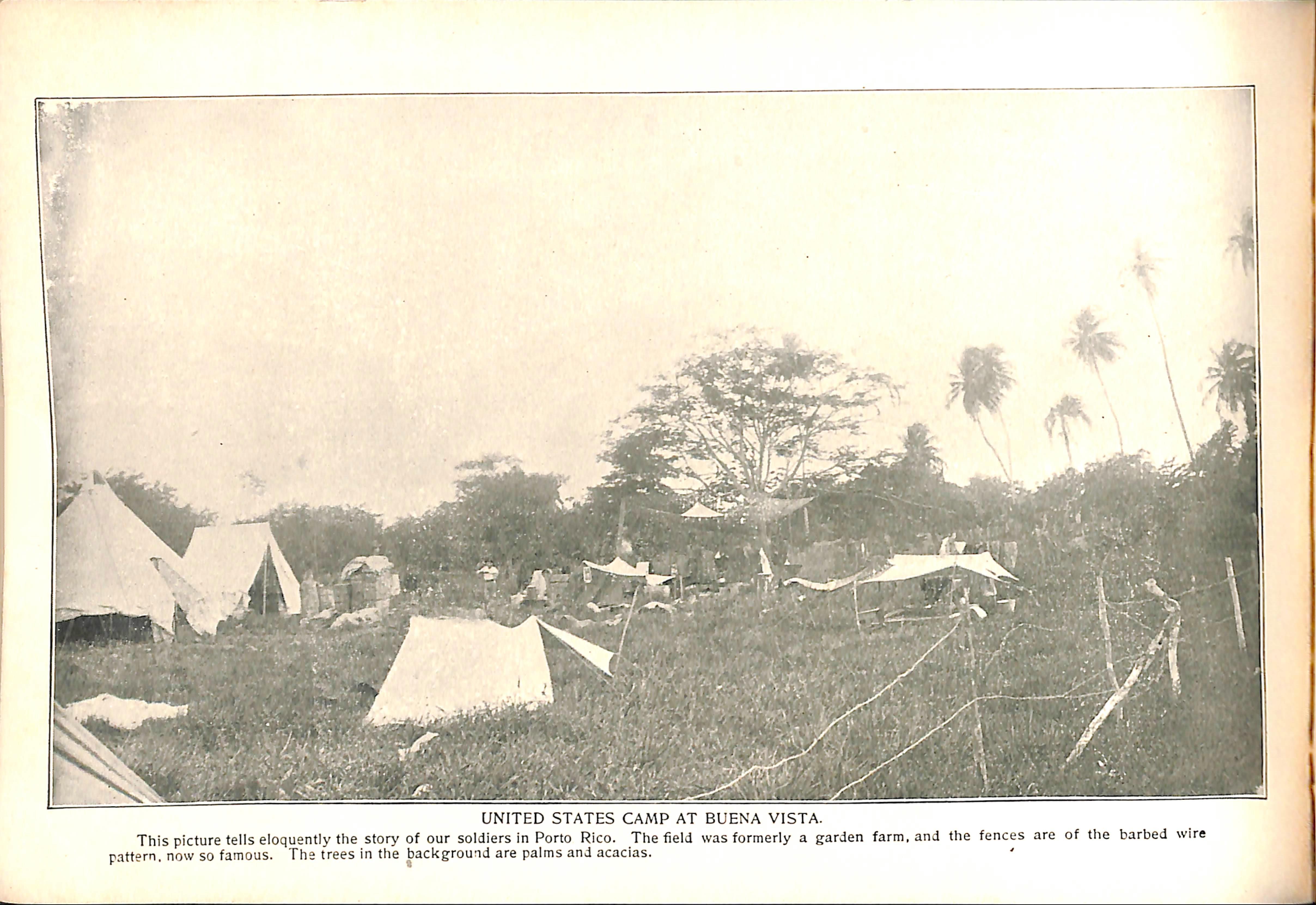
Yauco is built upon a hillside which. while inconvenietn lo the traveler, is of great advantage to the sanitation. the rain water sweeplng all the dirt and refuse into the strram. which ru'is Inio the valles' below
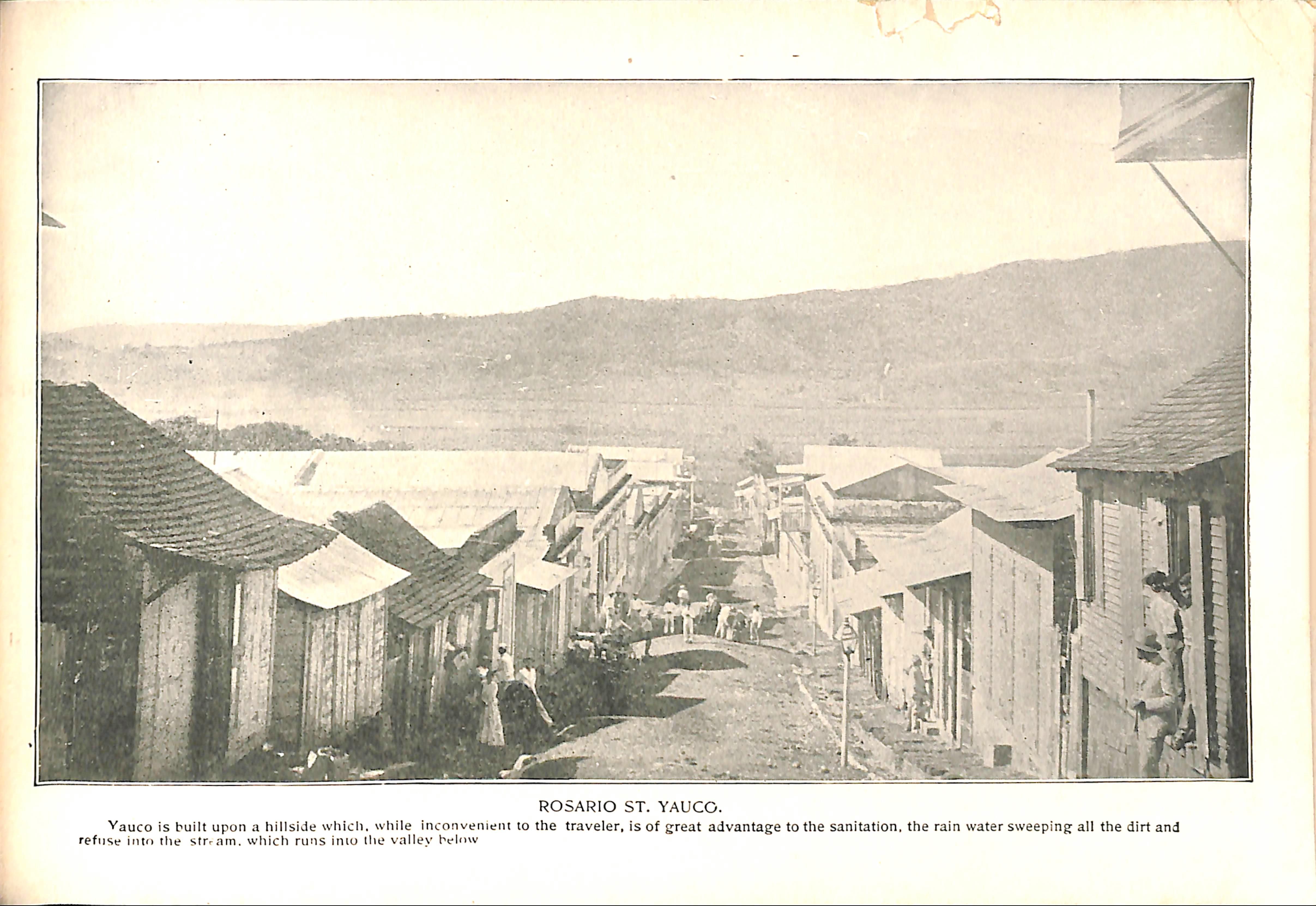
TYPICAL NATIVE FARMERS.
The farming- class is about on a par witli the poor dirk'es down South, aii J varies much even in race and color, ranging from Spanish white trash to fviU-blooded Ethiopiaiis.
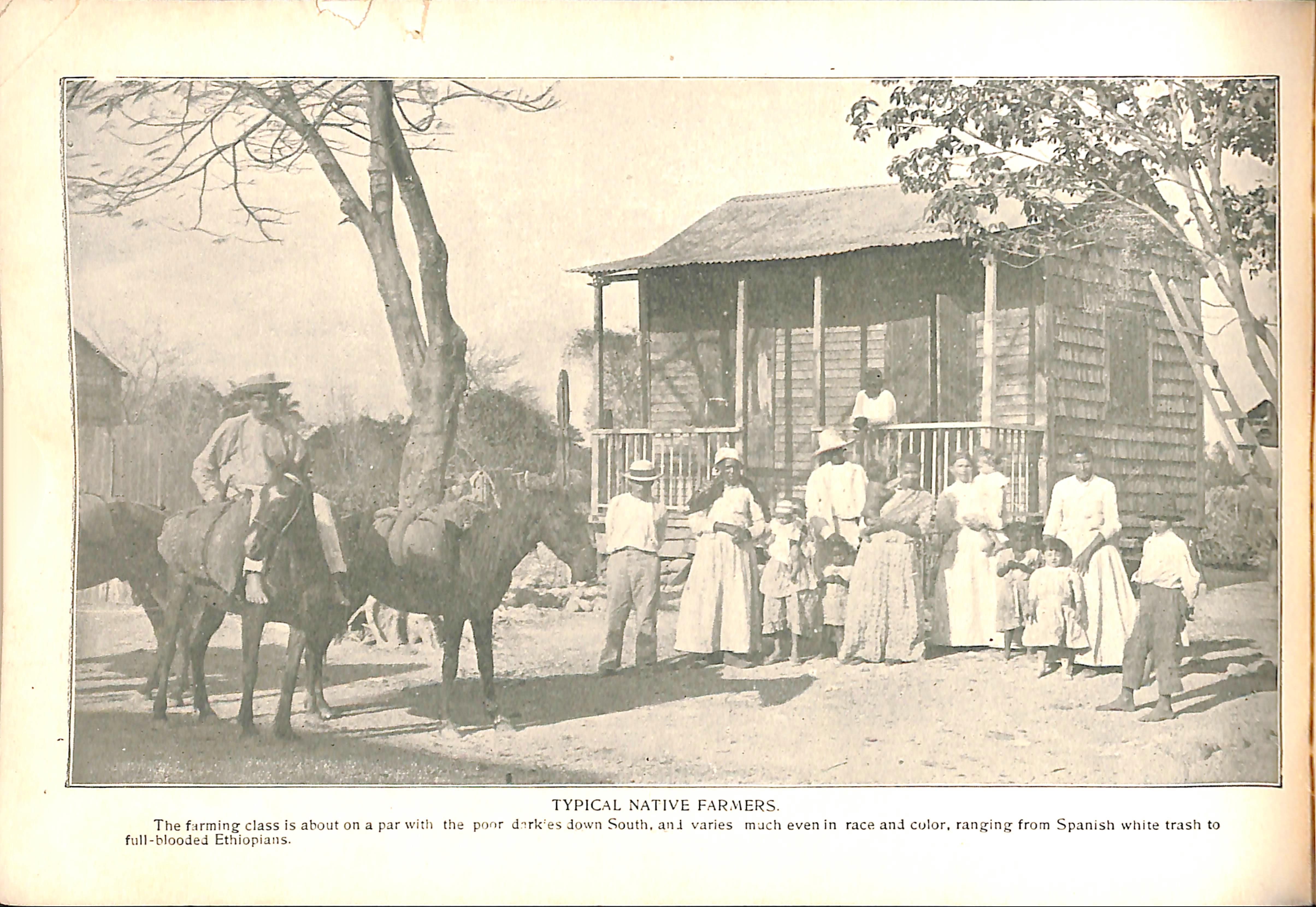
BRIDGE ON THE MAIN ROAD FROA^ PONCE TO ADJUNTAS. ^
There is a deep porpe at this point which, in the rainy season, is filled with strong: aad danírerous currents The brid^e was. therefore. built ven' high so dS t<i allow free movement to the surciní: waters. In order to save expense it was built so as to utiliza the rocky mountaln side. which hnes one part OT tile river. Bevond the briJ^e the road is cut in the mountain. which. at some places, has been blasted out so as to form a wide shelf.

Thi^pretty park ís famous ín Porto Rico. Itwaslaid out in the last century and contains many odd forms of veffetation. Among:thcce are acacias, which, when they flower, look like masses o^ fíame ; screw palms, yuccas, Spanish bayonets, india rubber trees, cocoanut palms and cacti. In ene córner Is a very pretty Moorish music stand ; in the background to the left is an oíd cathedral, and to the right ¡s the Hotel Inglaterra.

DR PARRI5H AND THE UNITED STAIES HOSPITAL STAFF, PORTO RICO STATiOX.
Dr. EdwarJ Parrish is the second from the rie:ht. and the rest are the staíf who take care of the old-fashioned hospital where they are stationed.•It will be noticed that the yard is paved with stones and that the flower pots are cid aie casks and wine barréis. There are no cellars to these buildings.the main n.ior being level with the ground. They are of brick or of stone, stuccoed and whitewashed. Dr. Parrish had charge of hospitais at Mayaguez,etc.
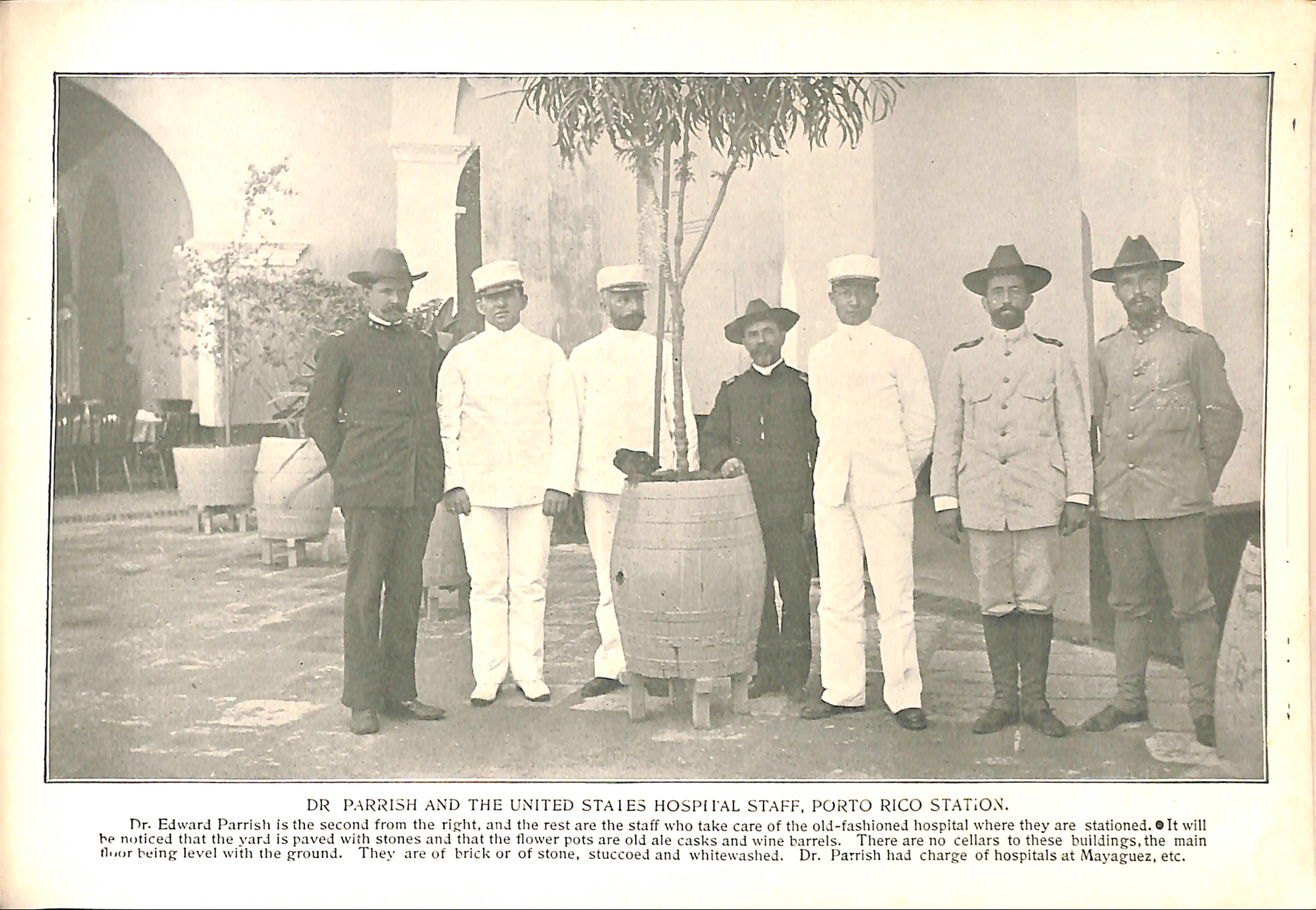
VíEW OF PONCE FROM A SMALL HILL OVERLOOKING THE TOWN.
In the immediate foresrround is a quainí littie Spanish cemetery where the closeness of the graves is a marked feature. T5ie country rounJabout is very level, and ¡s cultivateJ with g;cat care.

The well-filled storajie sheds of the pícture and the insignificant creek where goods must be loaded and unloaded upon I¡g;hters, tell their own story of Spanish maladmlnistration. The money paid in landing fees each year would more than build a long and commodious pier,where the ships could be loaded directly.


 Taken by //'. C.Jltnvlami.
THE CHAPLAIN OF THE THIRD MISSOURI.
The band ¡s at the rig-ht, chaplain in center and the choir at left.
Taken by //'. C.Jltnvlami.
THE CHAPLAIN OF THE THIRD MISSOURI.
The band ¡s at the rig-ht, chaplain in center and the choir at left.



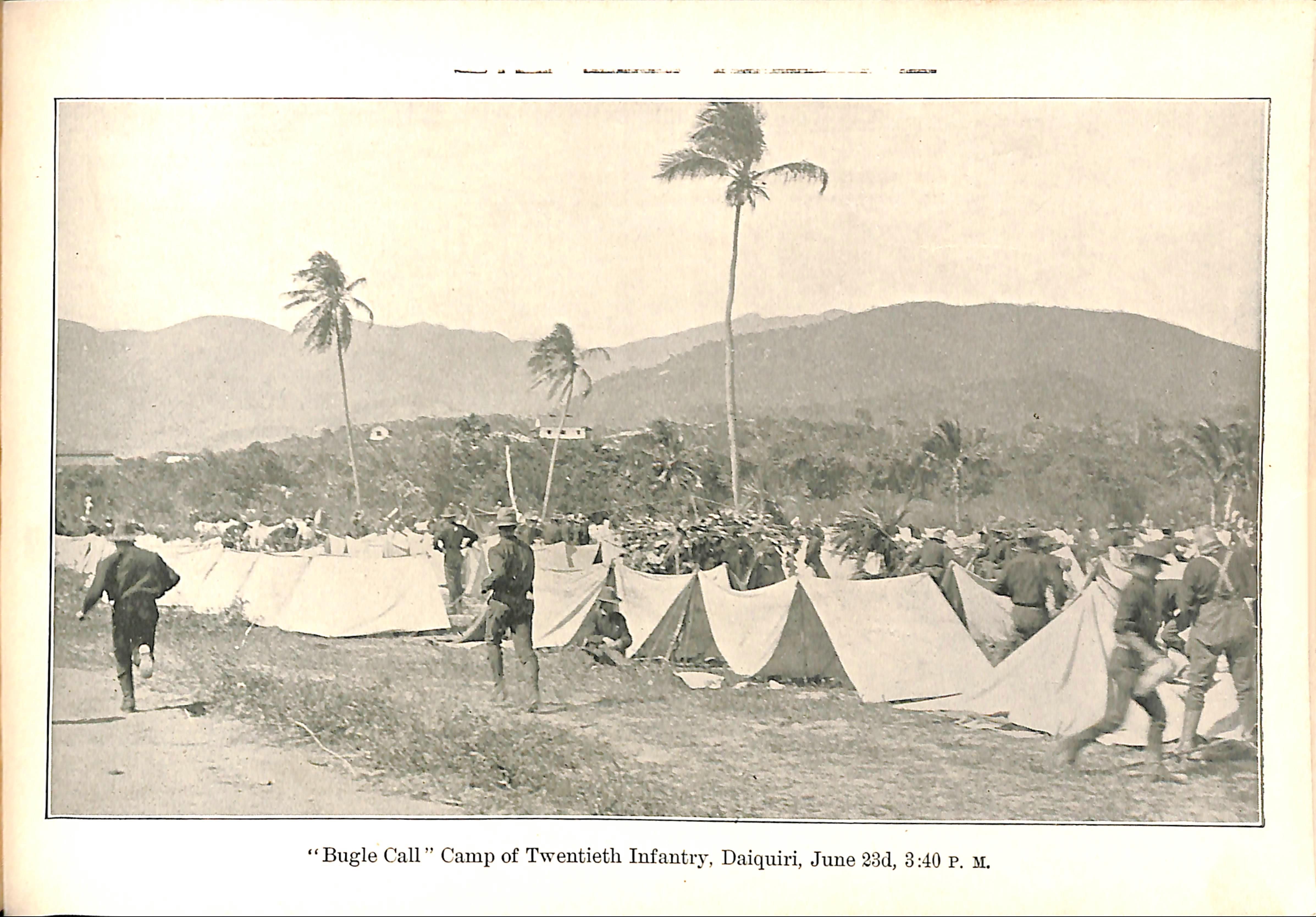
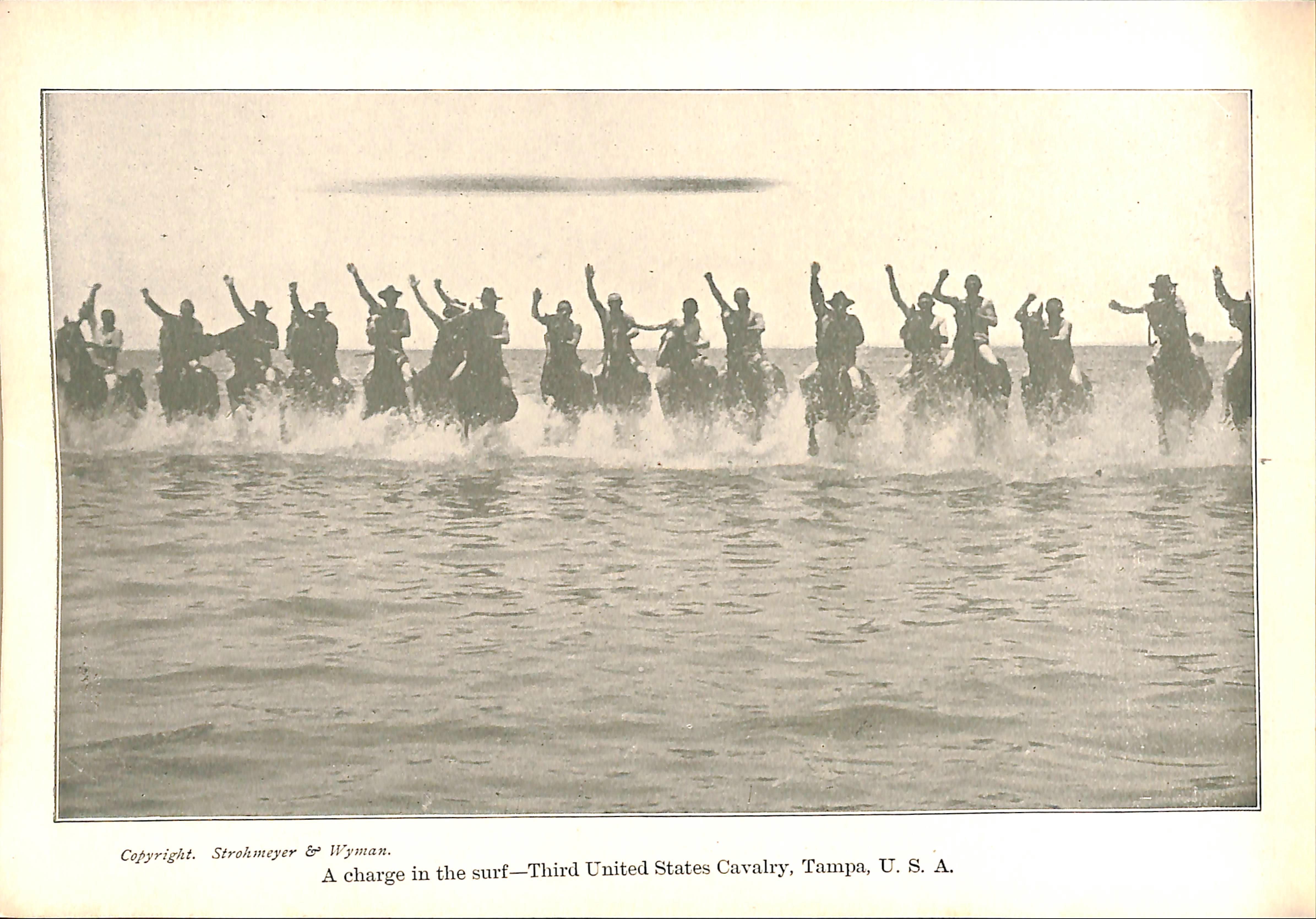
TaA'en hy //', C.J-Íowland.


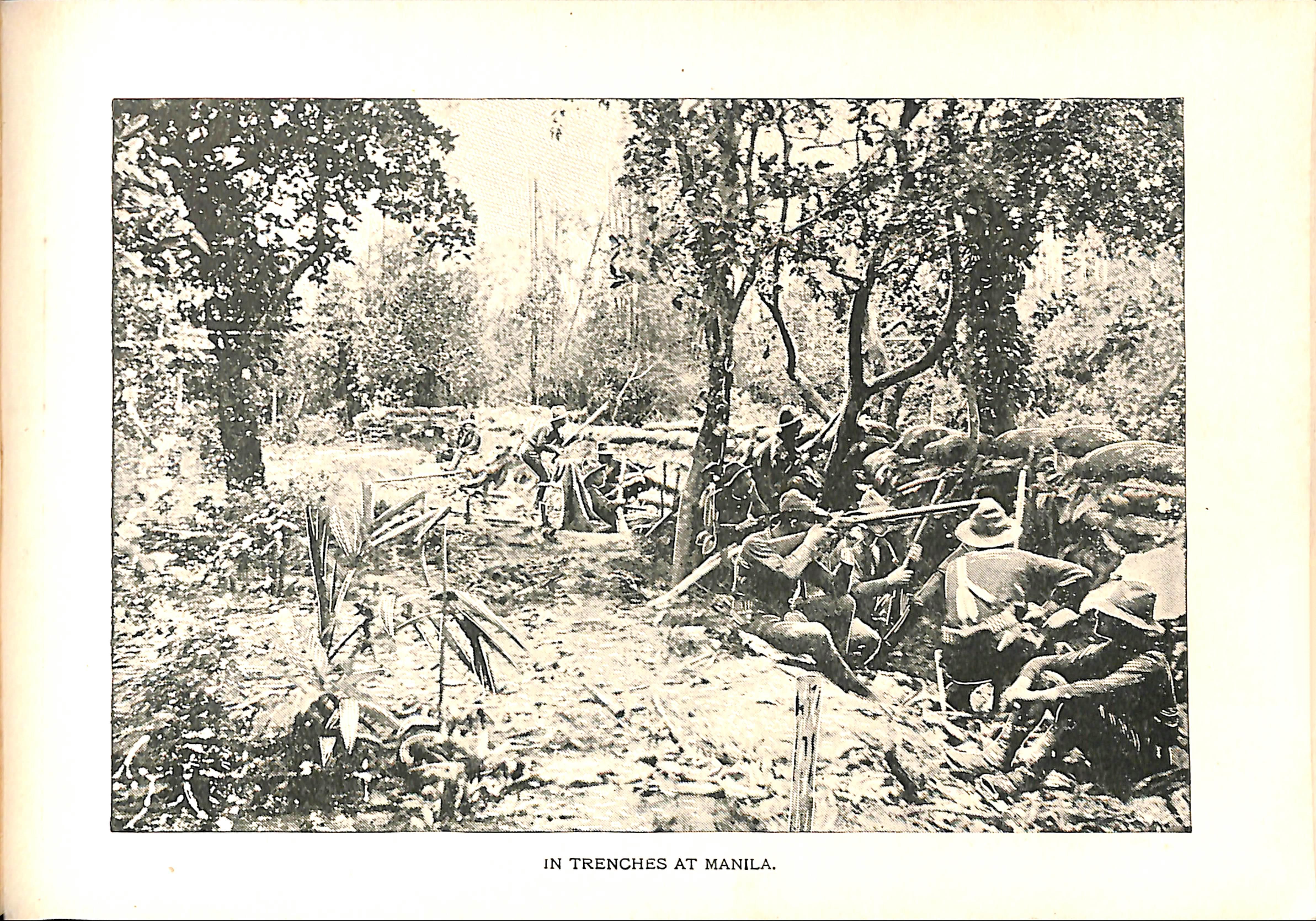
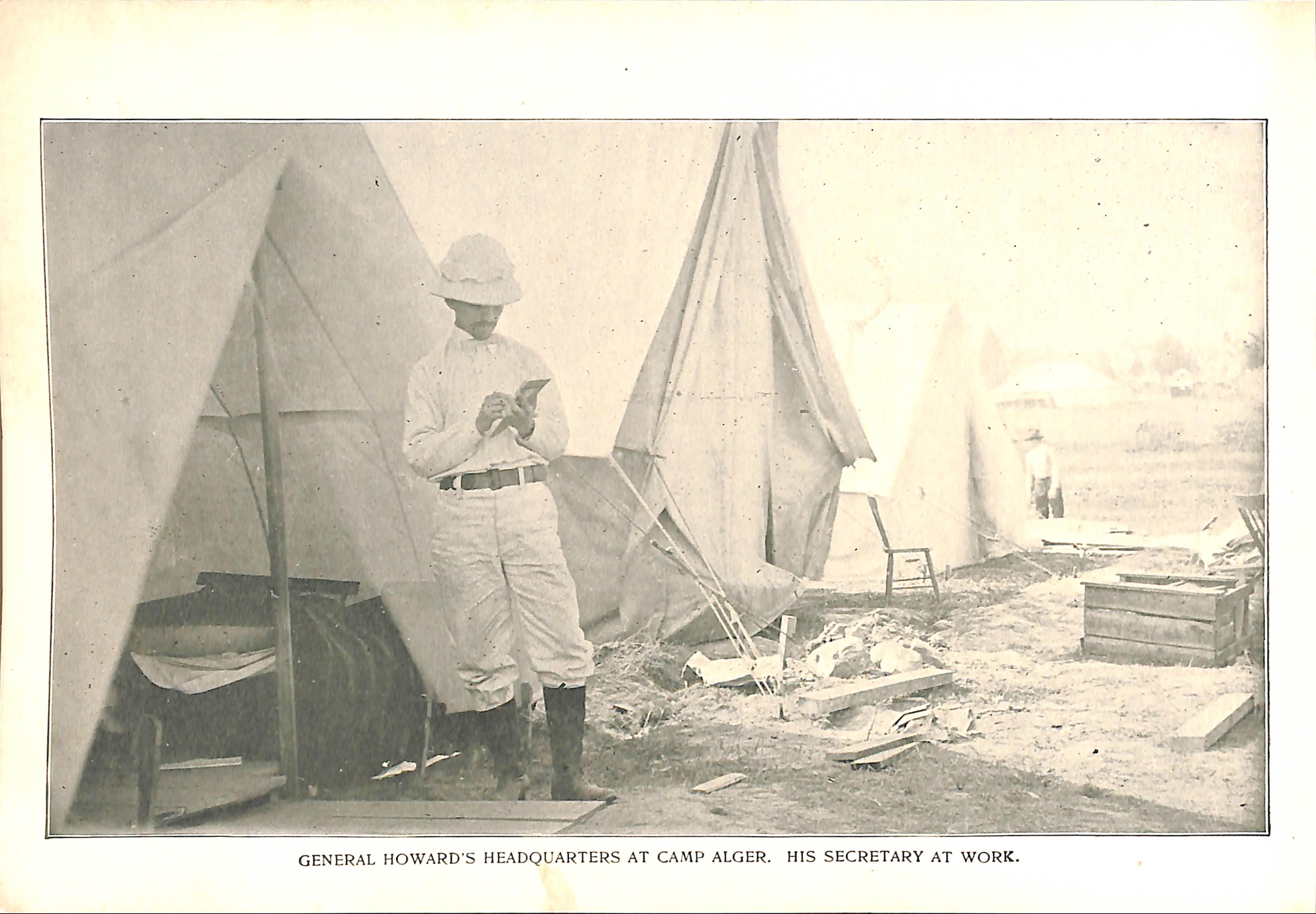


Copyright, Strohvteyer £¡f Wyman, Major-General ("Fighting Joe")"Wheeler, tlie famous Confedérate cavalryman.
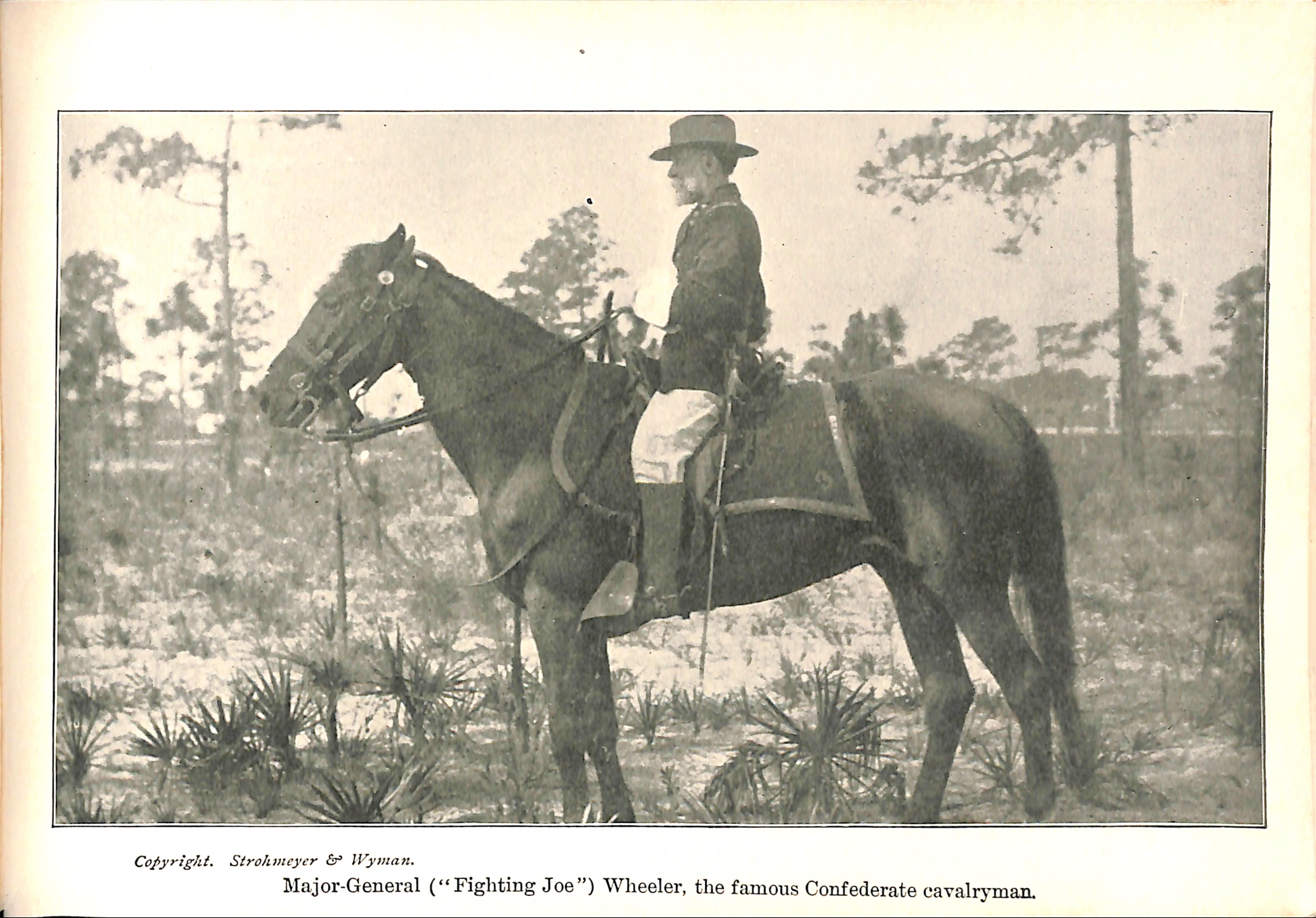
"THE
Bodies



Colonel Wood on El Paso Hill, morning of July Ist, taking first view of San Juan and Santiago, wliicli he was afterward to govern.

 General view of tlie artillery camp at Tampa. Transporta in the distance.
General view of tlie artillery camp at Tampa. Transporta in the distance.
About the attack to be made on El Caney in the morning, near General Shafter's headquarters, Sunday, Jnne 30th.
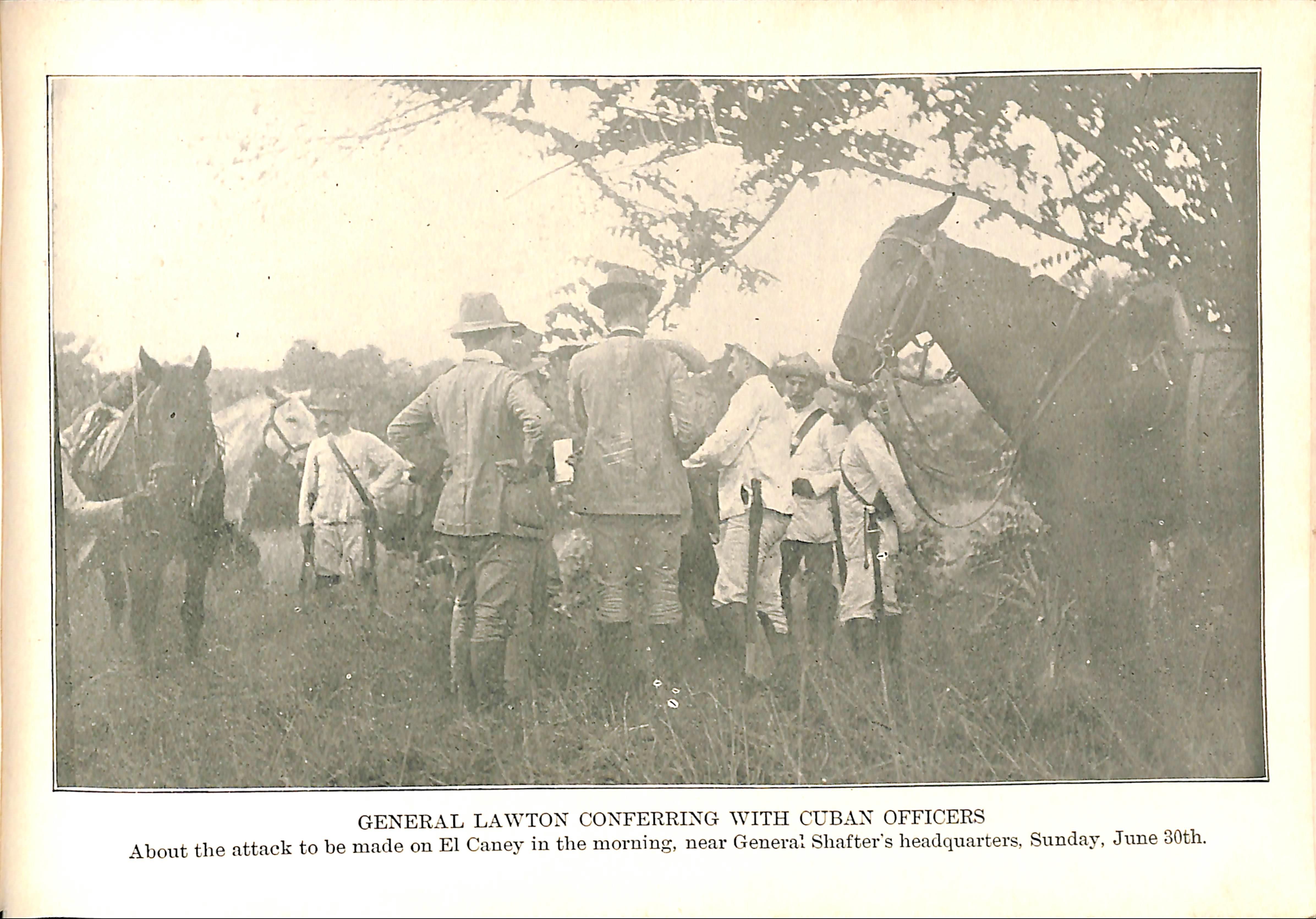
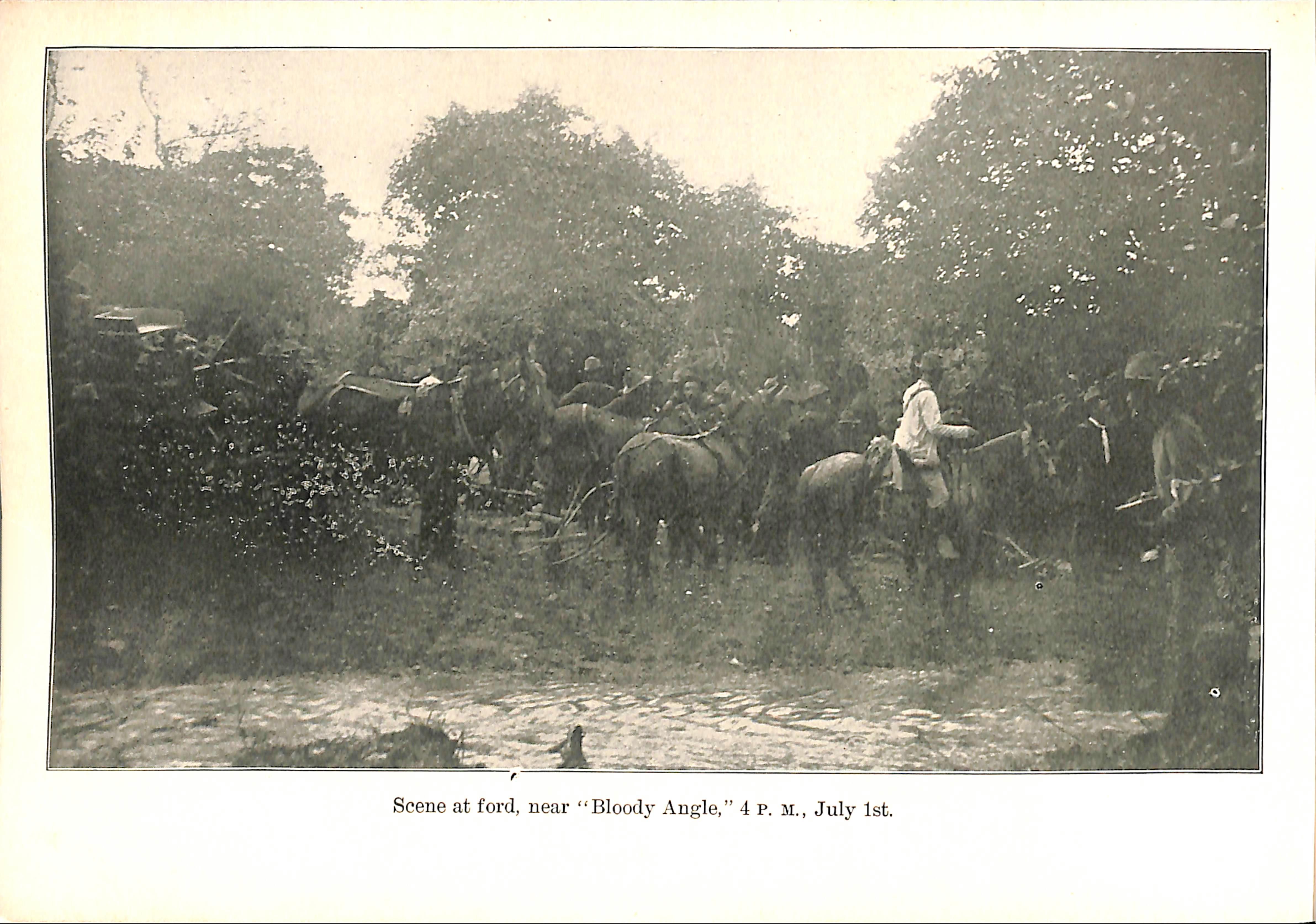 Scene at ford, near "Bloodj' Angle," 4 p. m., July Ist.
Scene at ford, near "Bloodj' Angle," 4 p. m., July Ist.
The "Mai'gavet" is the boat upon which General Wheeler's friends vrent down the bay to sea tlie transpoids start. This picture was taken ou tlie spot.


CAMP OF MICHIGAN VOLUNTEERS ON THE BAY.

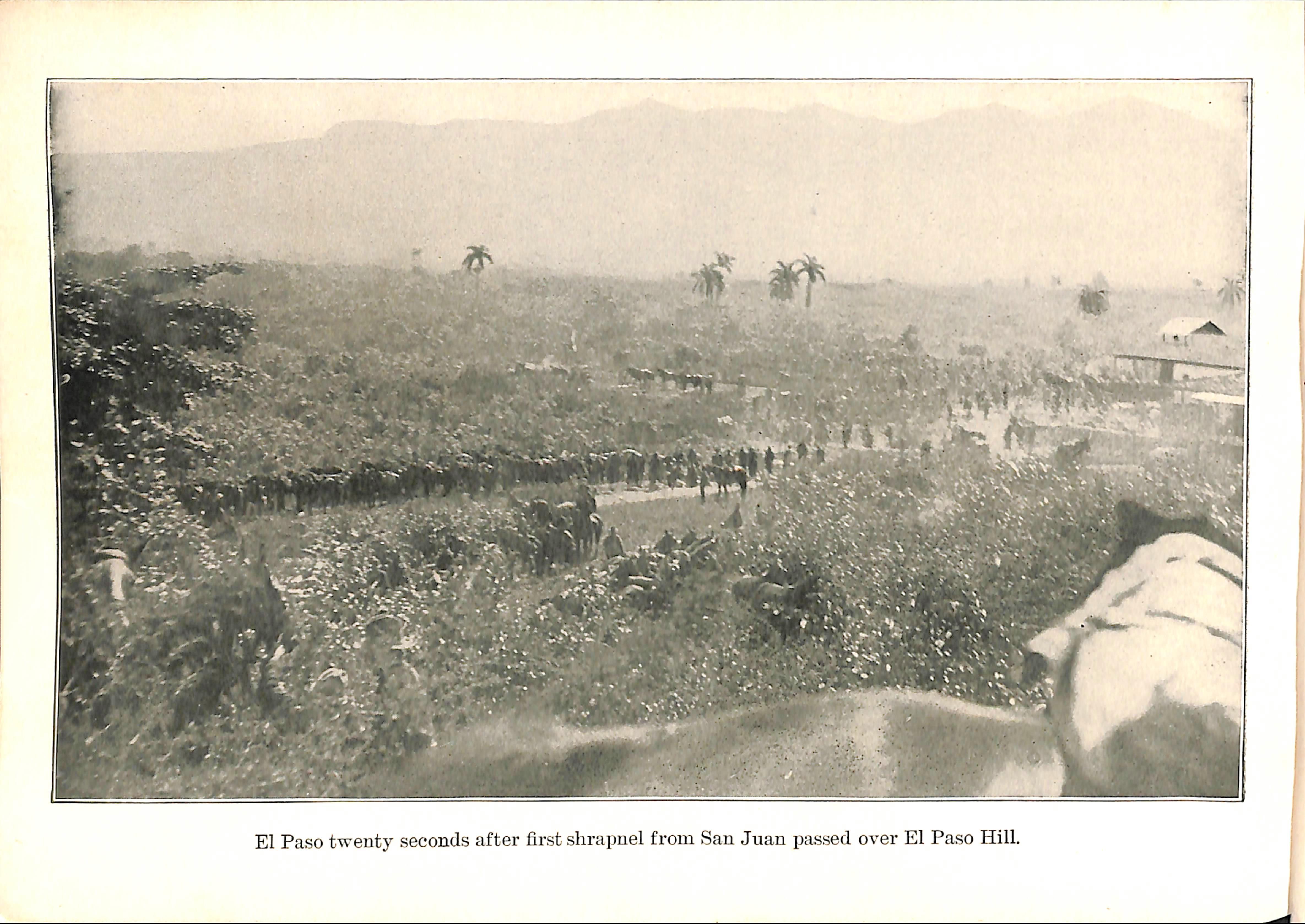
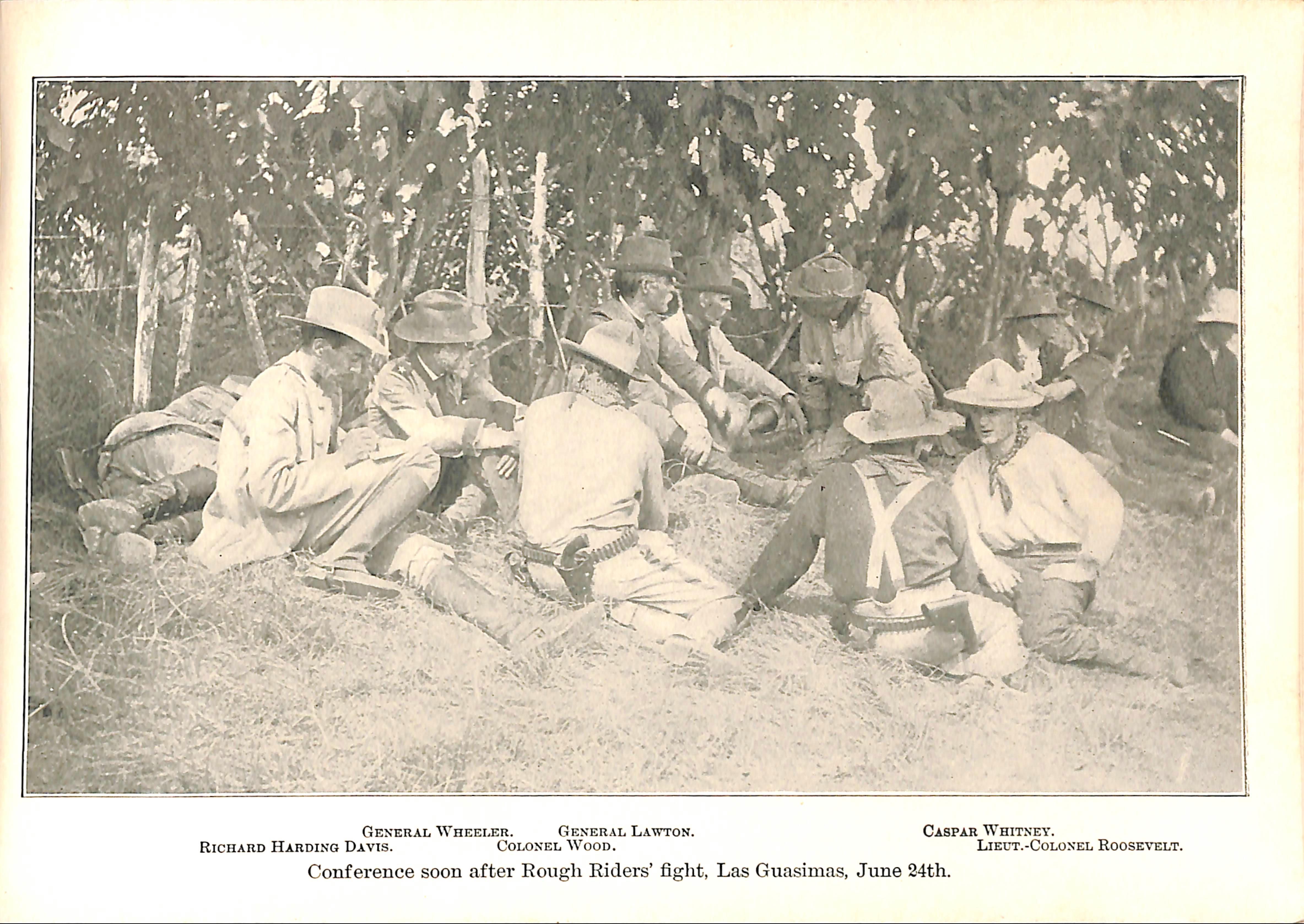
Thursday, June 30th, 4 p. m. This stream was forded many times by every man and animal that went to the front and was the only supply of drinking water.

HOSPITAL IN GENERAL WHEELER'S COilMAND.
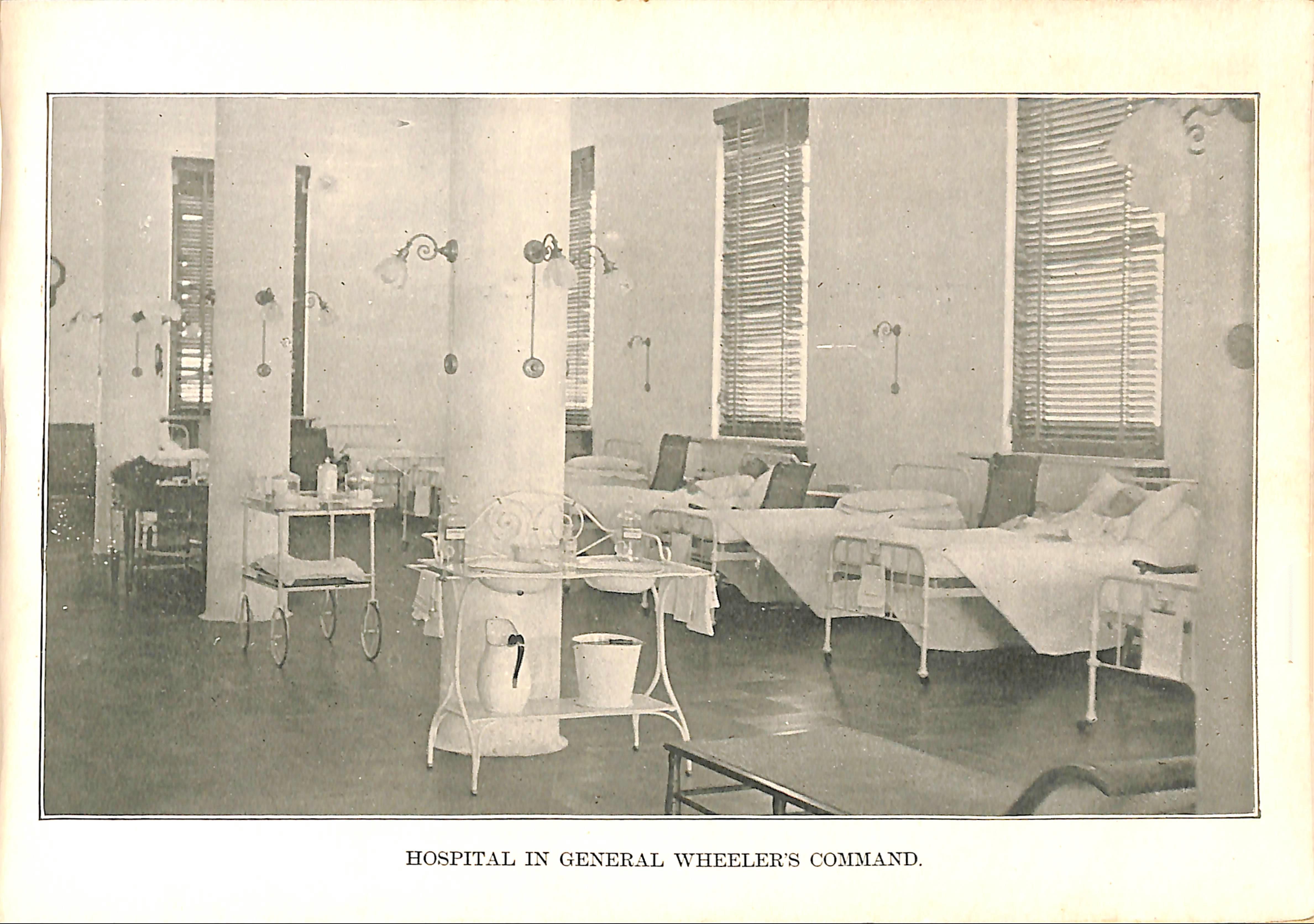
 Last photograph taken of Sergeant "WlLLIE"Tiffany. Henry Büll. Cr'tq Wadsworth. 'Willie" Tiffany. Going aboard the "Matteawan," Sunday, June 13th.
Last photograph taken of Sergeant "WlLLIE"Tiffany. Henry Büll. Cr'tq Wadsworth. 'Willie" Tiffany. Going aboard the "Matteawan," Sunday, June 13th.
lieutenant wheeler.


HEADQUARTERS OF MAJOR-GENERAL BUTLER, Commanding the Second División of the Third Army Corps.
